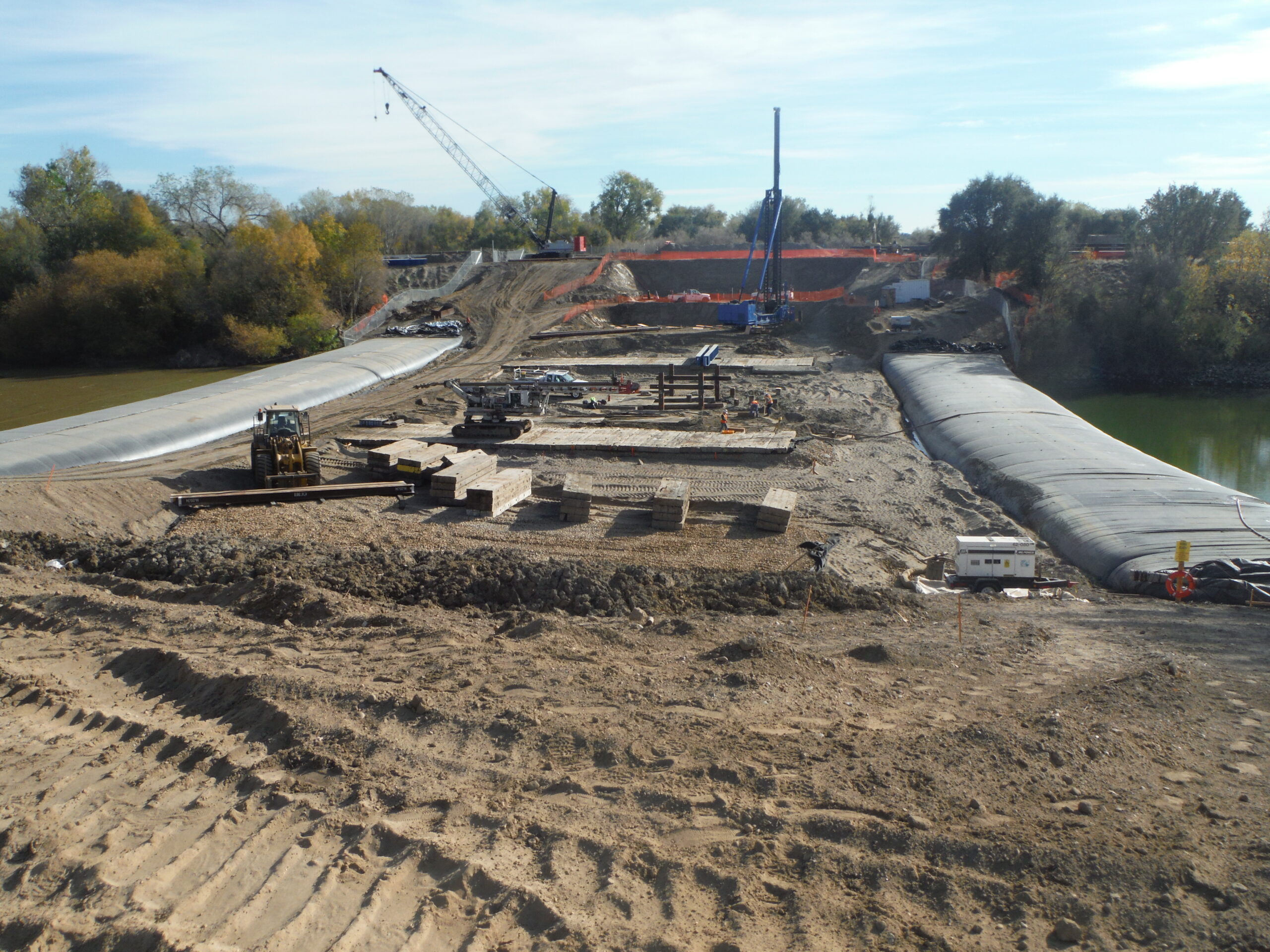
1.) Three 16ft tall 33ft wide 300ft long single closed end (SCE) AquaDams were used as a cofferdam system to build the McGowan Memorial Bridge in West Sacramento California. One of the three 16ft tall SCE AquaDams was a replacement dam, due to vandalism. These two 16ft tall SCE AquaDams have been installed in a staggered configuration.
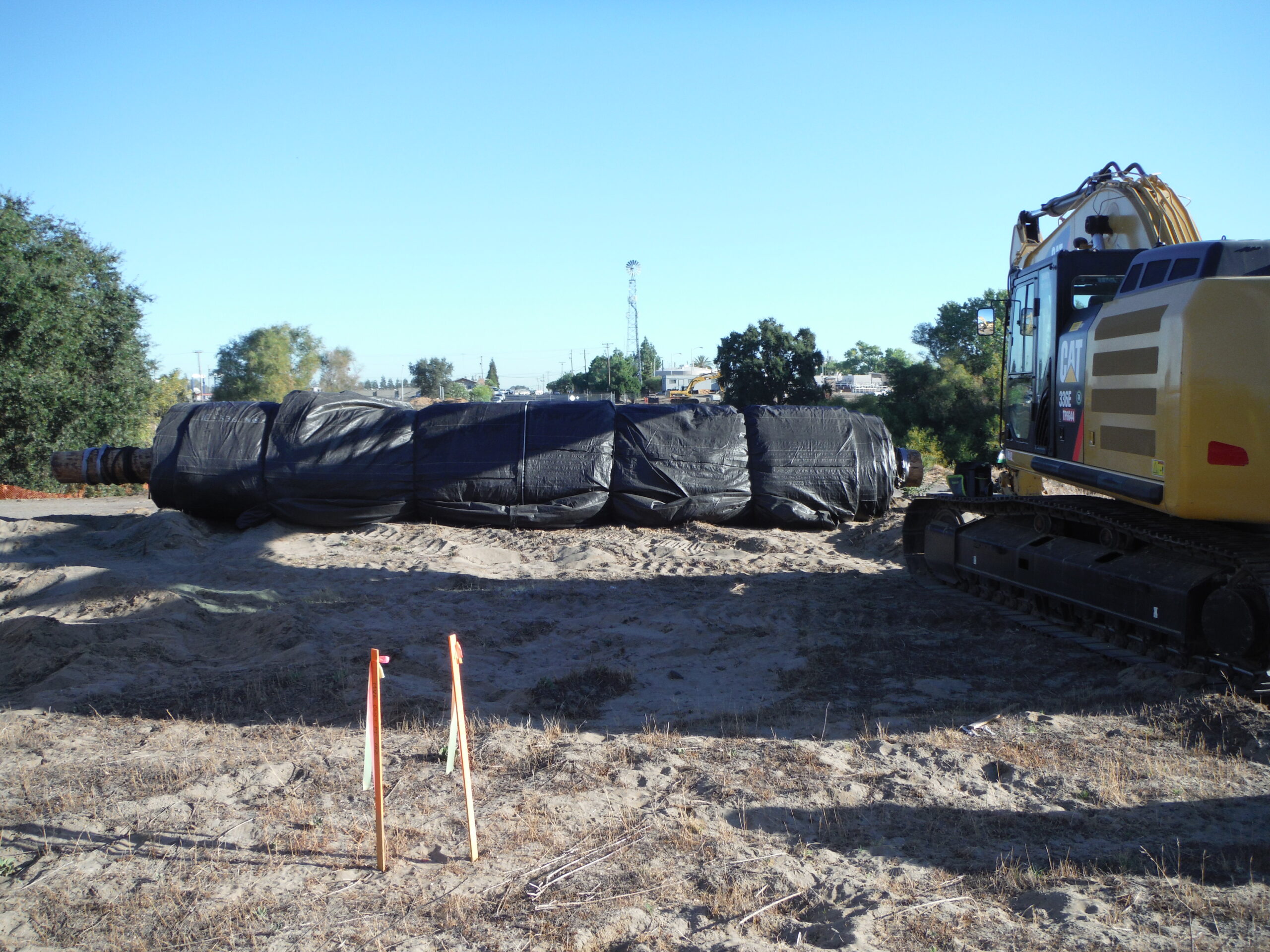
2.) The first 16ft tall SCE AquaDam has been delivered to the job site and is ready to be set at its starting bank. AquaDams are shipped rolled-up like a carpet roll, wrapped in a protective covering, and have lifting ropes/straps.
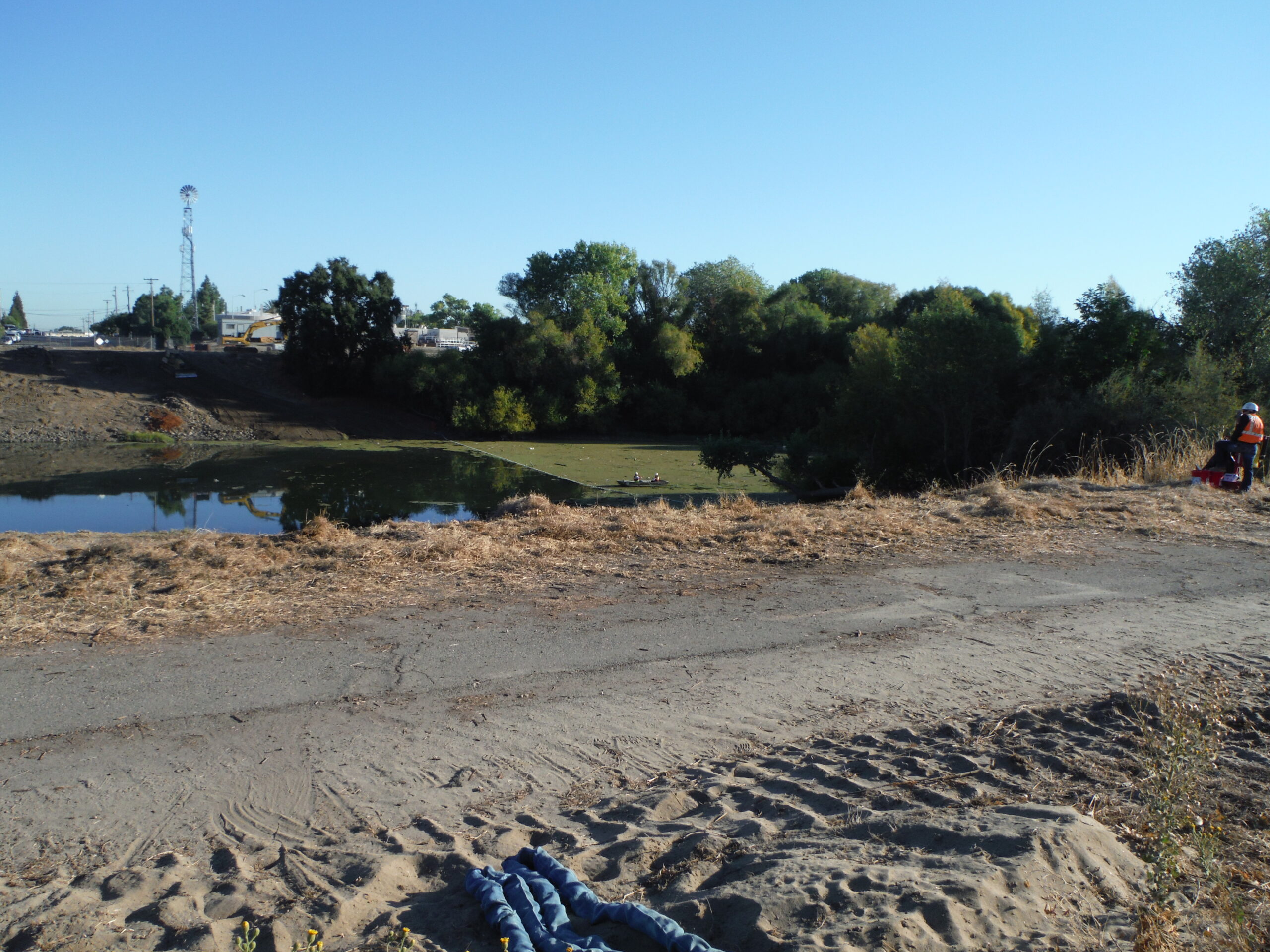
3.) The location of where the second 16ft tall SCE AquaDam will be installed. To the right of this photo is East and the Sacramento River.
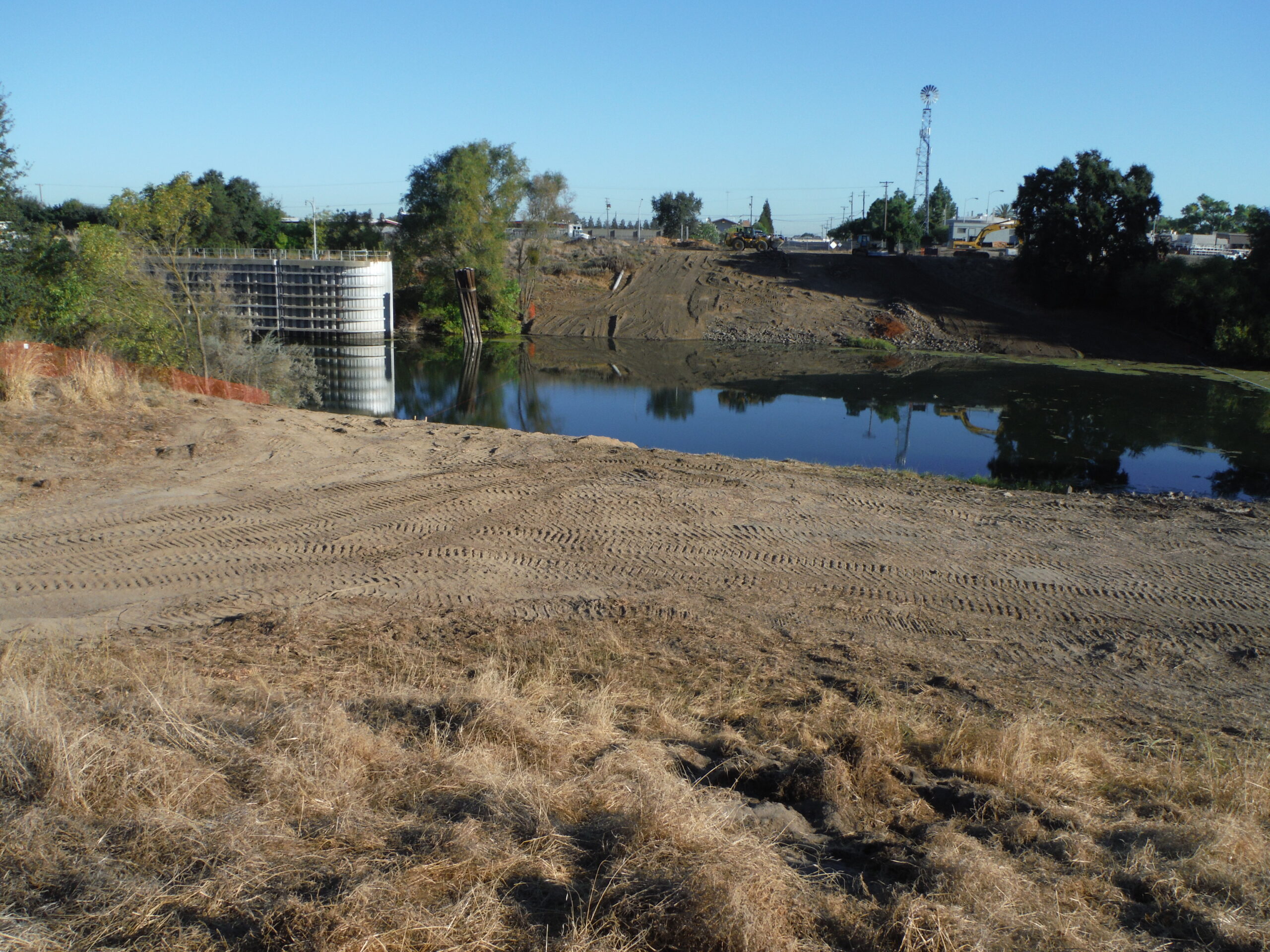
4.) The location of where the first 16ft tall SCE AquaDam will be installed. To the left (West) is the locks that separate the Sacramento River Deep Water Ship Channel and the Sacramento River. This body of water is tidally influenced.
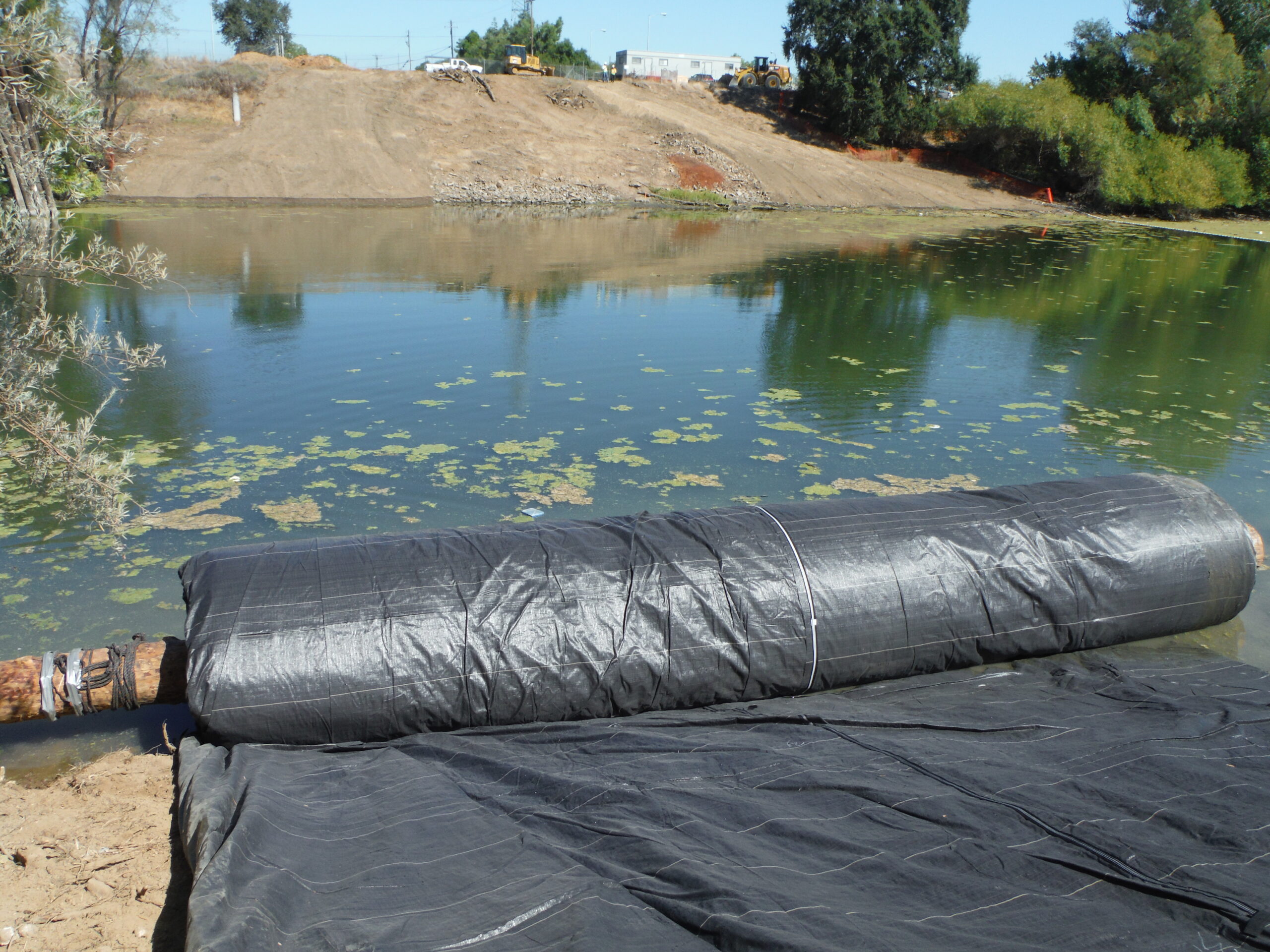
5.) The first 16ft tall SCE AquaDam has been launched from its starting bank. AquaDams are made of light weight flexible materials and will float when empty in deep enough water.
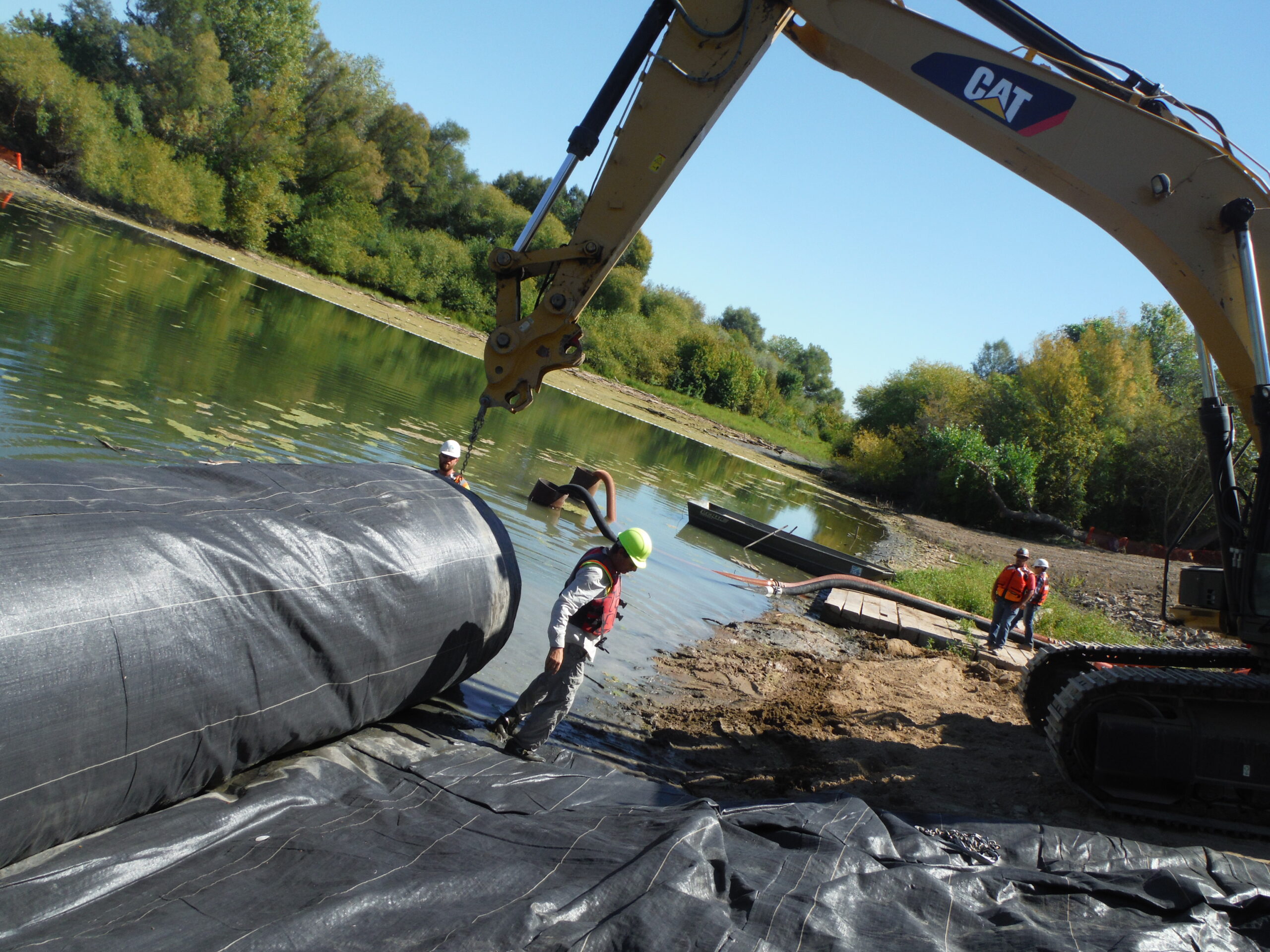
6.) The roll end of the AquaDam needed to be shifted so that it would be on the right path towards the ending bank. It is best to do any moving or shifting prior to filling the unit with water because the water will add additional weight.
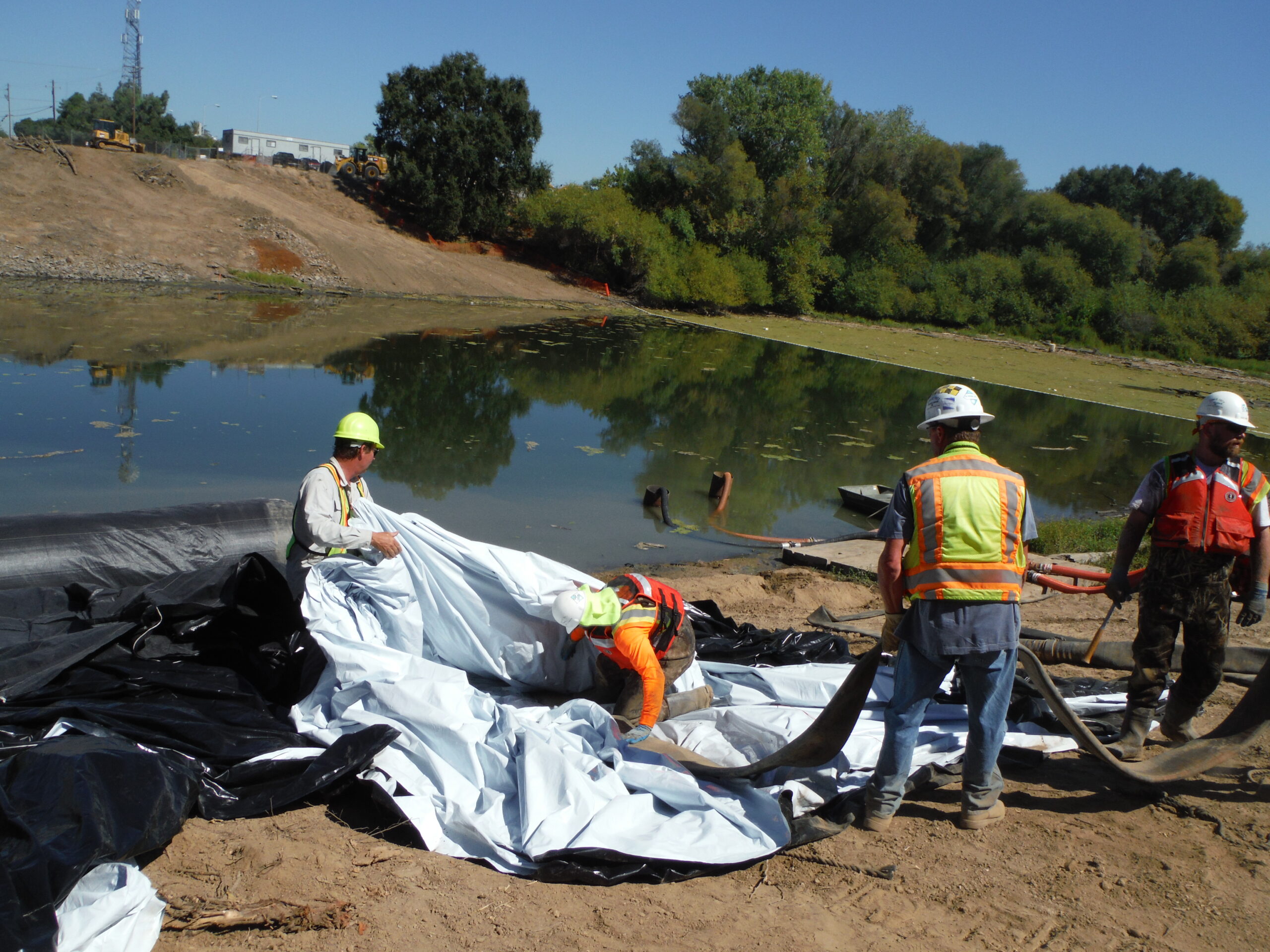
7.) Now that the first 16ft tall SCE AquaDam is in the desired position, workers place discharge hoses (from pump) into the fill-tubes of the SCE AquaDam. The end of the discharge hose inserted into the fill-tube should not have any fittings and needs to go far enough down the starting bank to ensure the water goes to the toe of the bank.
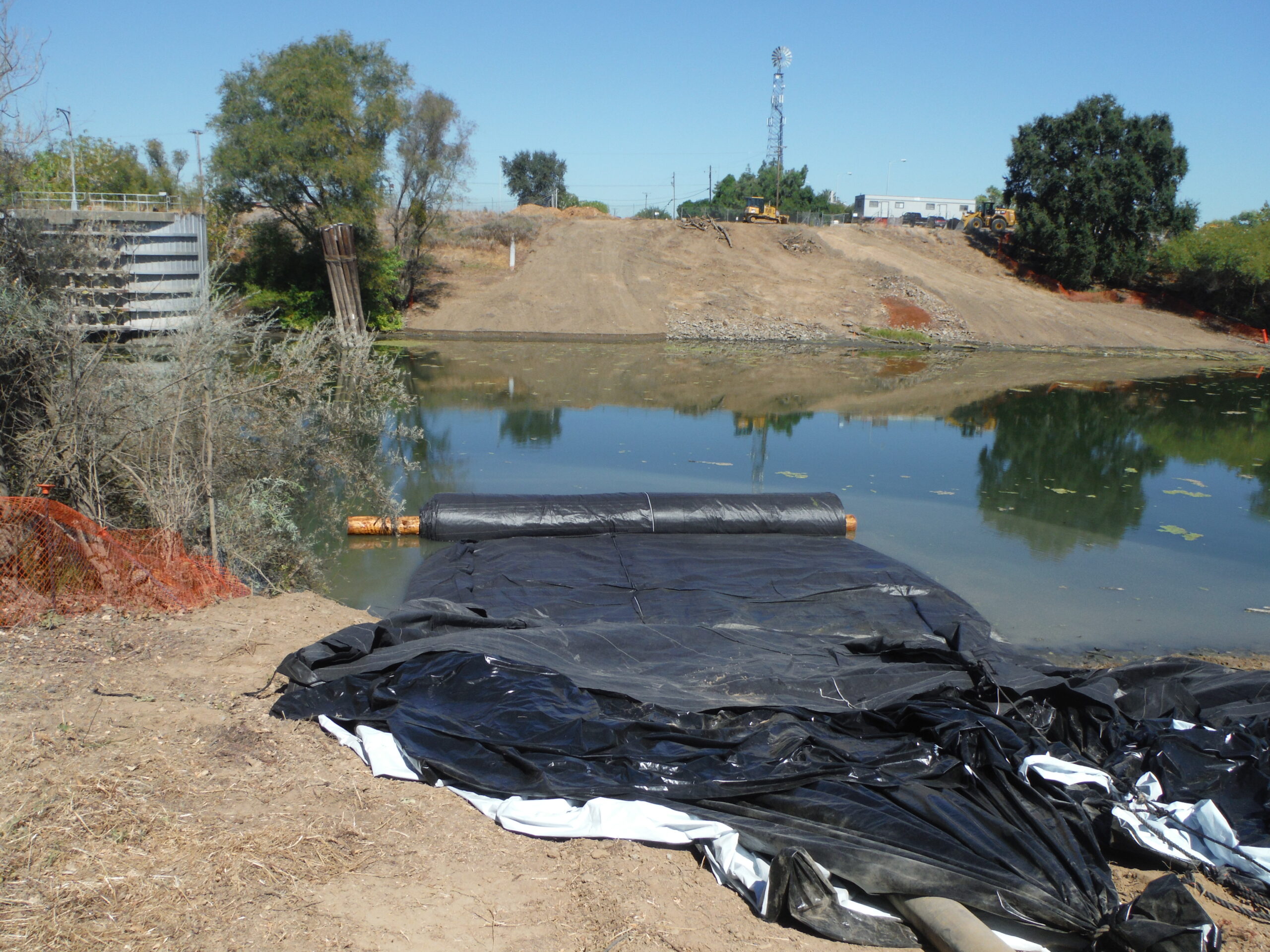
8.) The first 16ft tall SCE AquaDam has begun to be filled with water. Here we can see the starting point (open end) and the fill-tubes of the SCE AquaDam.
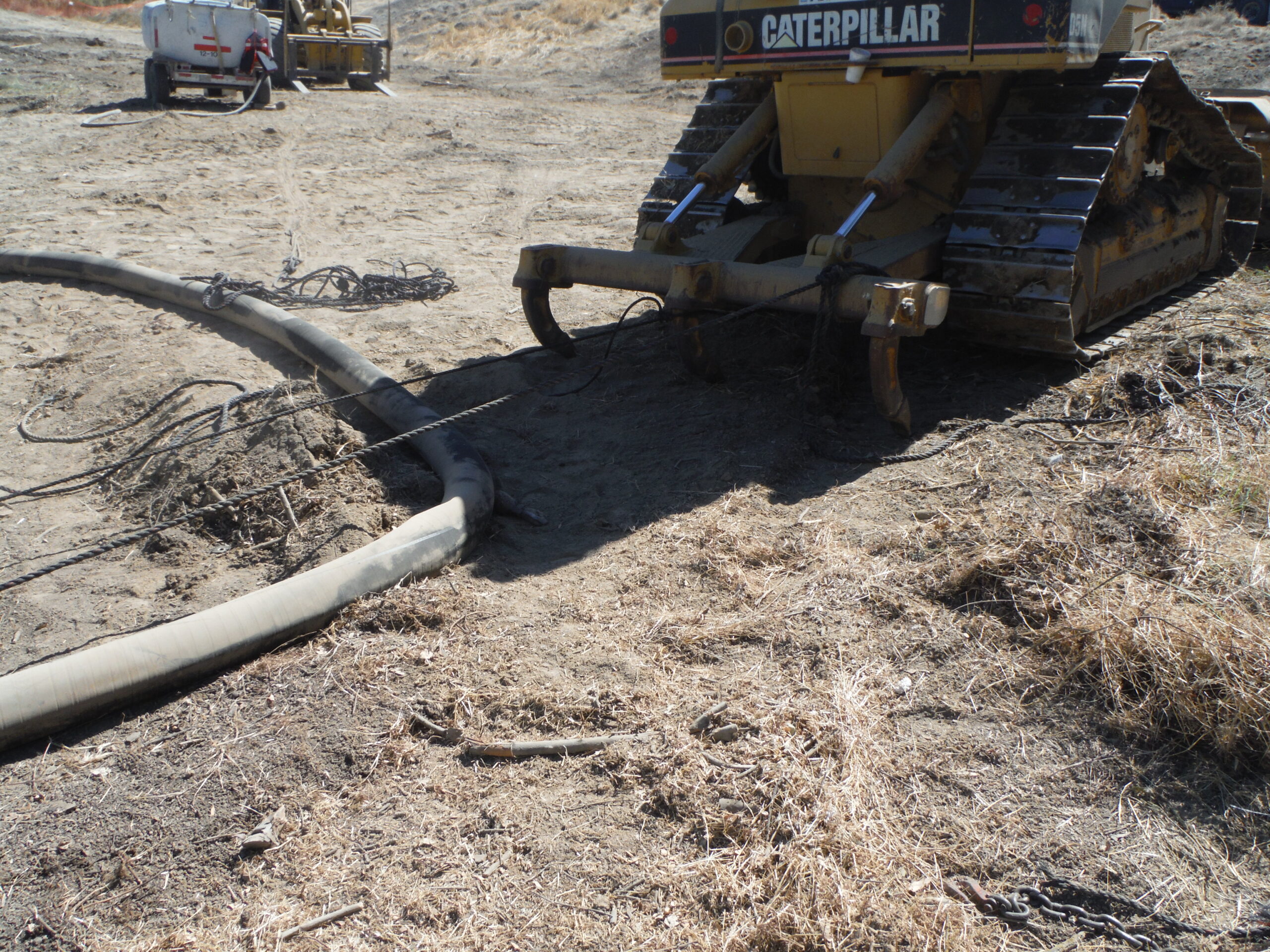
9.) The open end of the first 16ft tall SCE AquaDam has been tied back to this CAT dozer. The open end of a SCE AquaDam should be tied up the starting bank to help keep the unit in place while it fills.
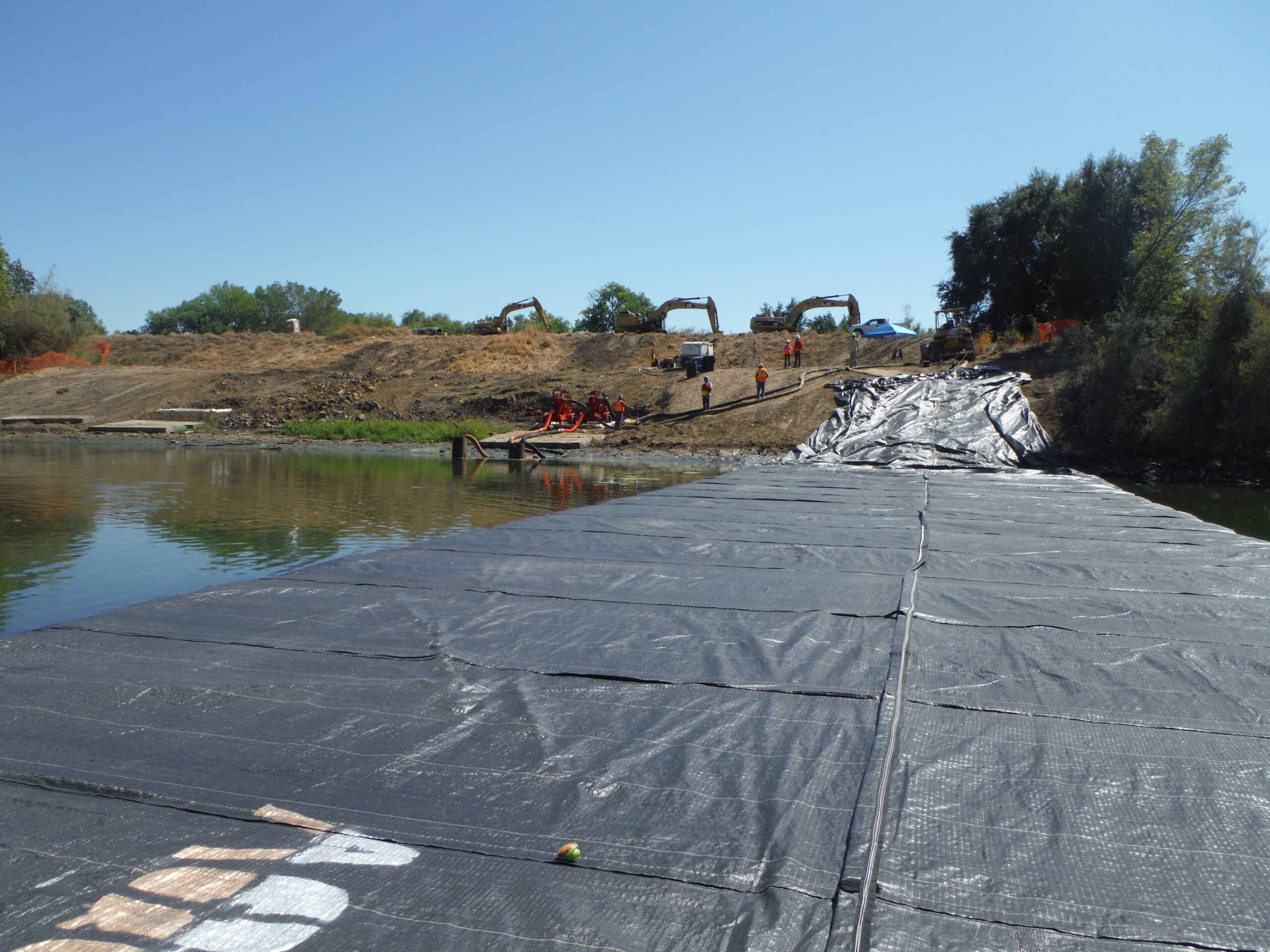
10.) A photo taken standing on the 16ft tall SCE AquaDam, looking back at the starting bank. Notice how tall the bank looks, the open end needs to be elevated higher than the top of the full AquaDam along its given path. An AquaDam will only reach its full height at the lowest elevation along its path.
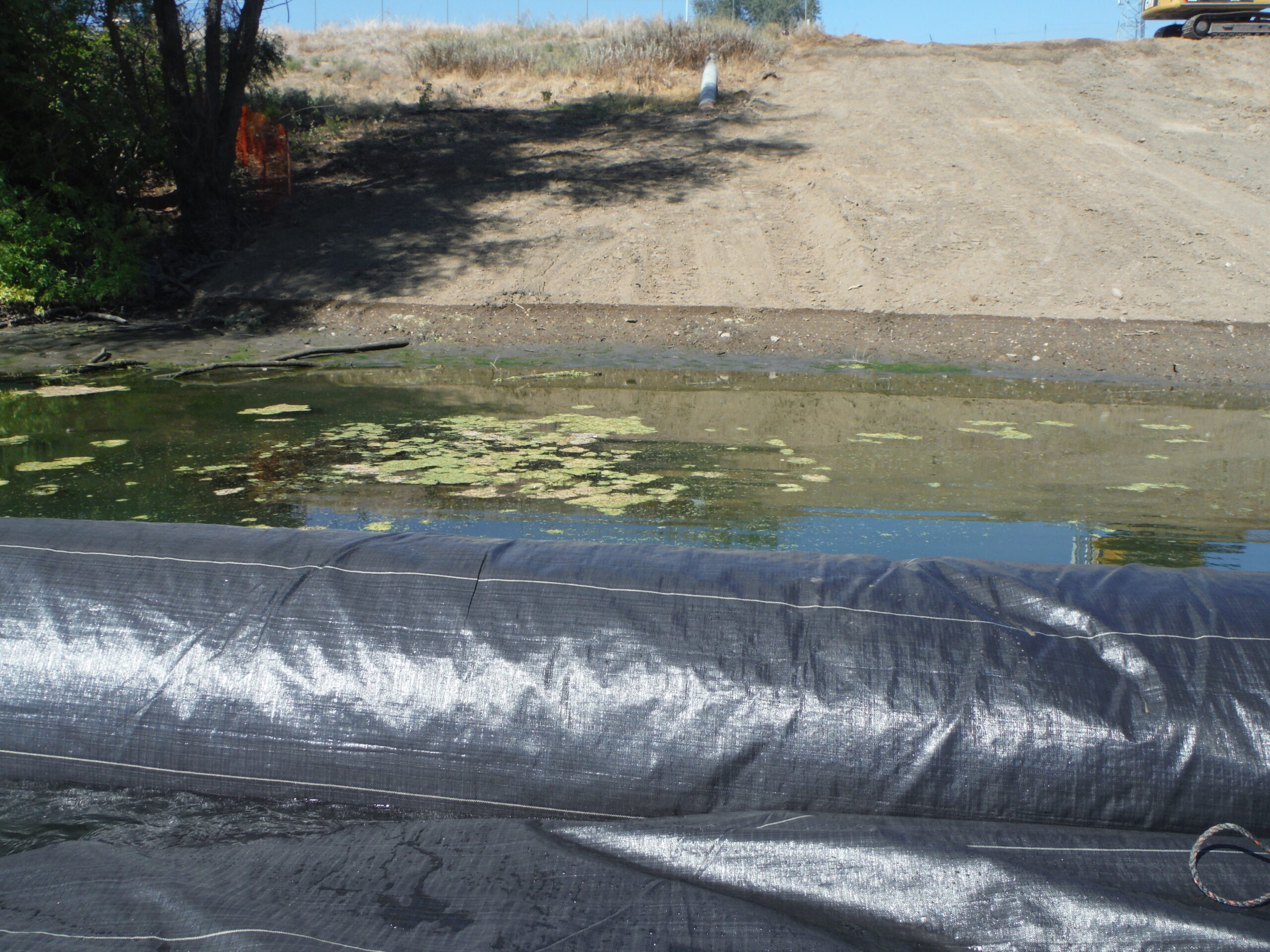
11.) The first 16ft tall SCE AquaDam continues to fill. The tide has changed since the start of this installation, we can see the water line at the ending bank. When considering the maximum controllable depth of an AquaDam for a project that is tidal, knowing the tide’s influence on the water depth is critical.
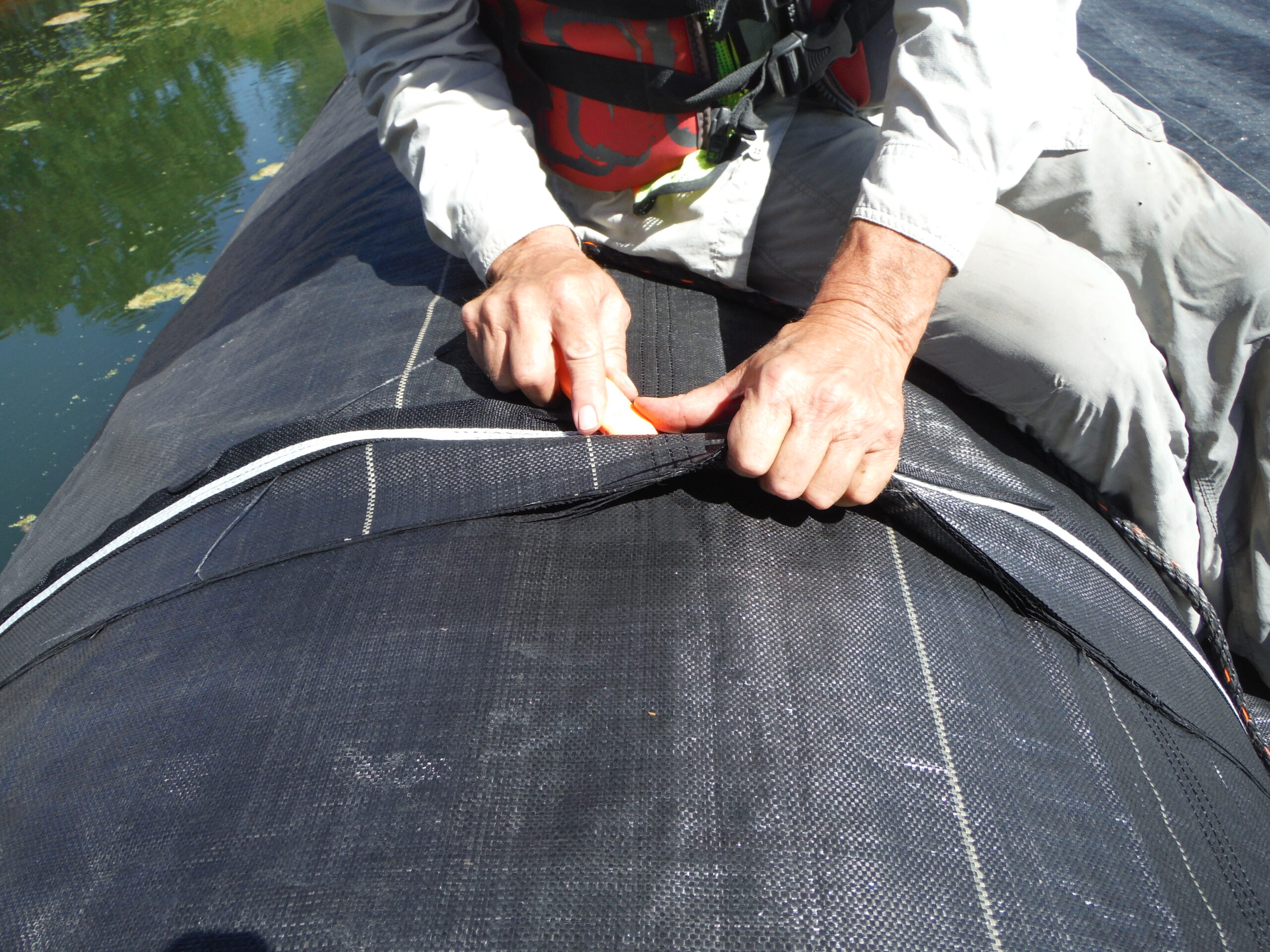
12.) A worker cuts a hole in extra material on the bottom seam of the 16ft tall AquaDam to tie a rope too. This rope along with a few others will be used to hold the roll stationary, while AquaDam is filled with water. The workers wanted to keep a temporary gap open at the ending bank to allow water to continue to flow until after the next high tide. By waiting for the next high tide workers will be able to capture more on the work area side, which is where the pumps are drawing from.
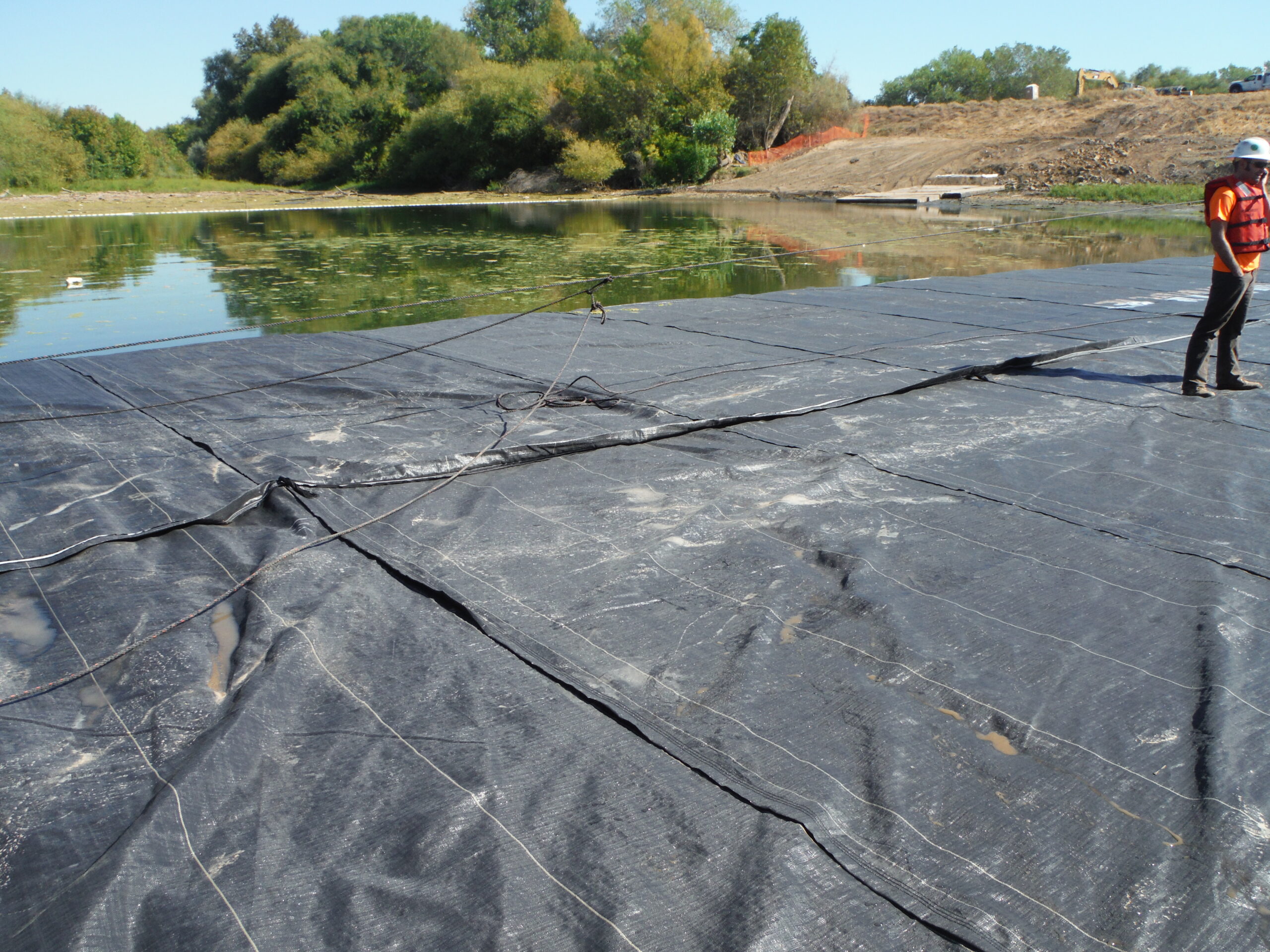
13.) Ropes were also tied to the two ends of the log the AquaDam was rolled on as well. The more ropes tied off at various locations along the roll will give better control.
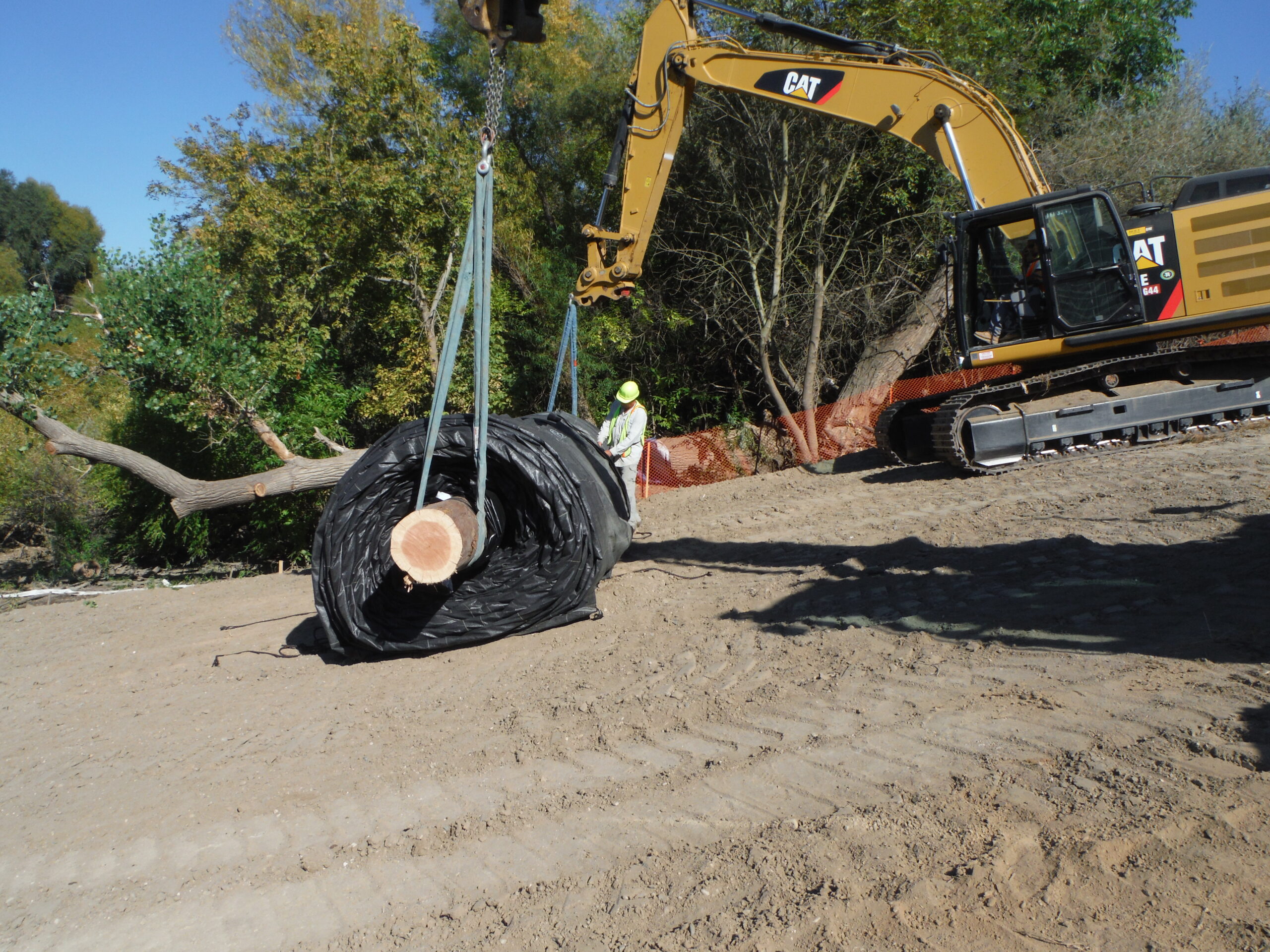
14.) While the first 16ft tall SCE AquaDam was tied off and filling, the second dam was placed at its starting bank.
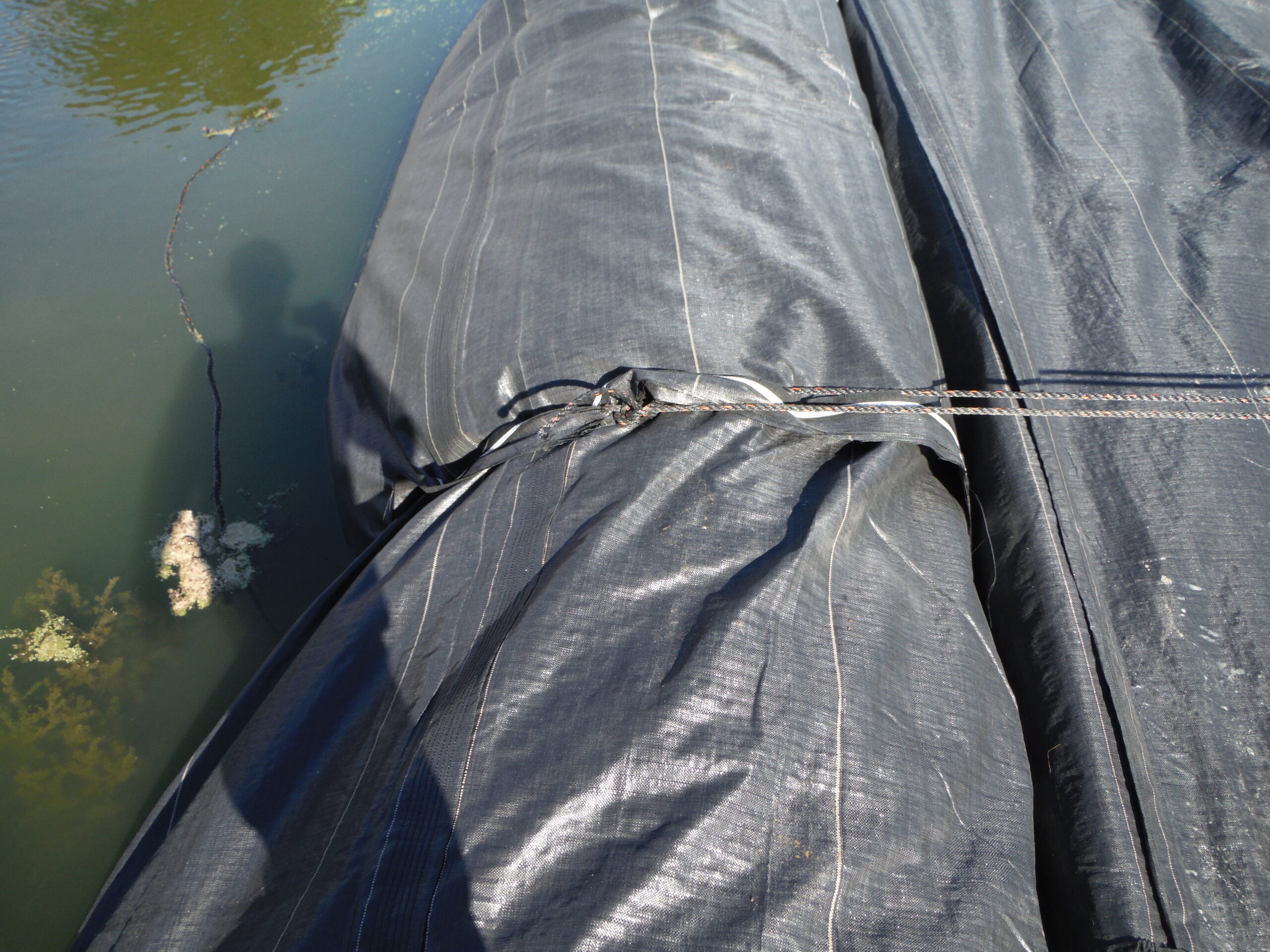
15.) The ropes that were tied to the extra material on the bottom seam of the first 16ft tall SCE AquaDam have some tension in them in this photo. The tension will increase as the AquaDam is filled and builds head above the surround water.
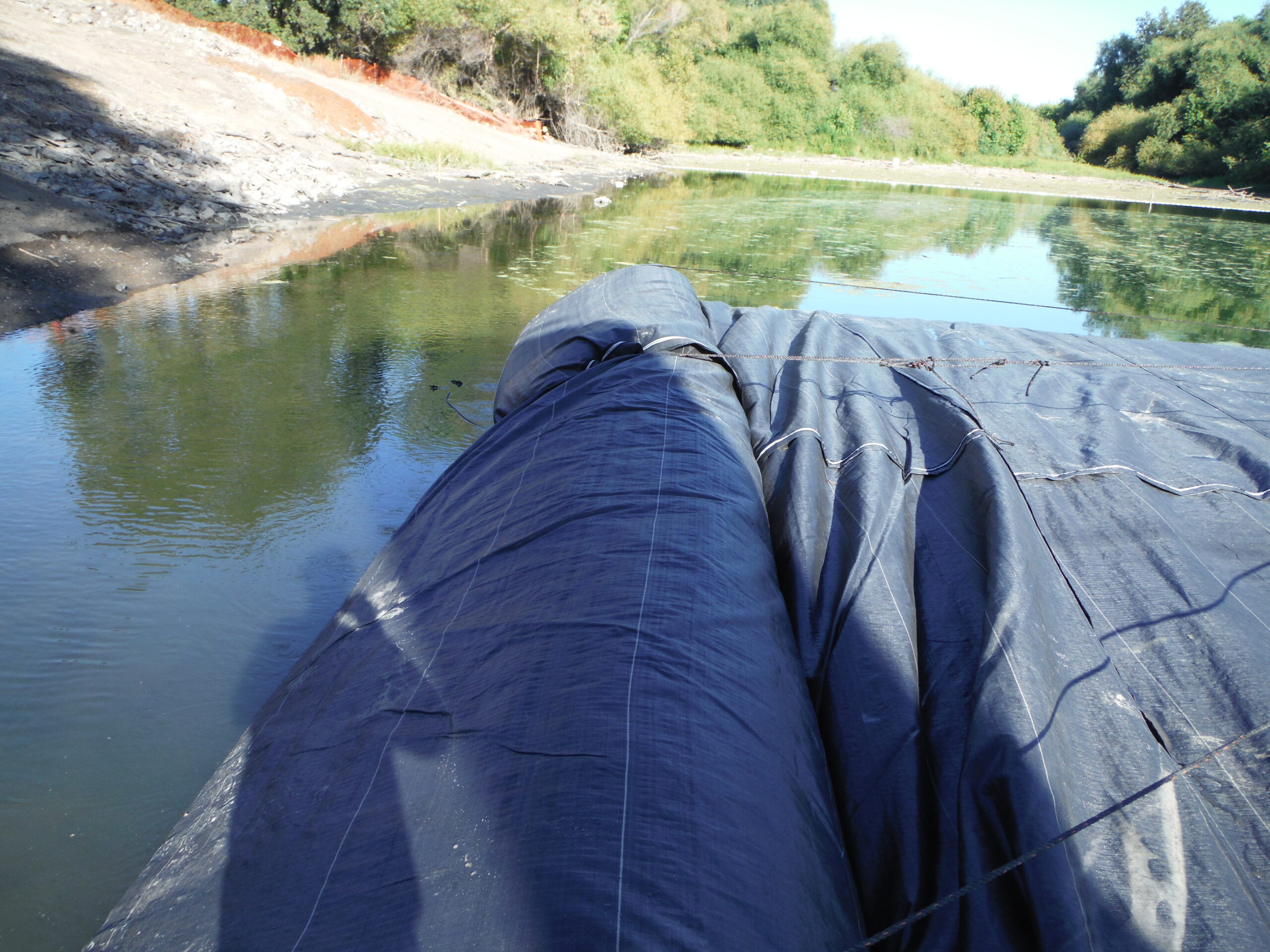
16.) Three ropes were used here one in the center and at each end of the log. The three tie points helped spread the force out and ease control.
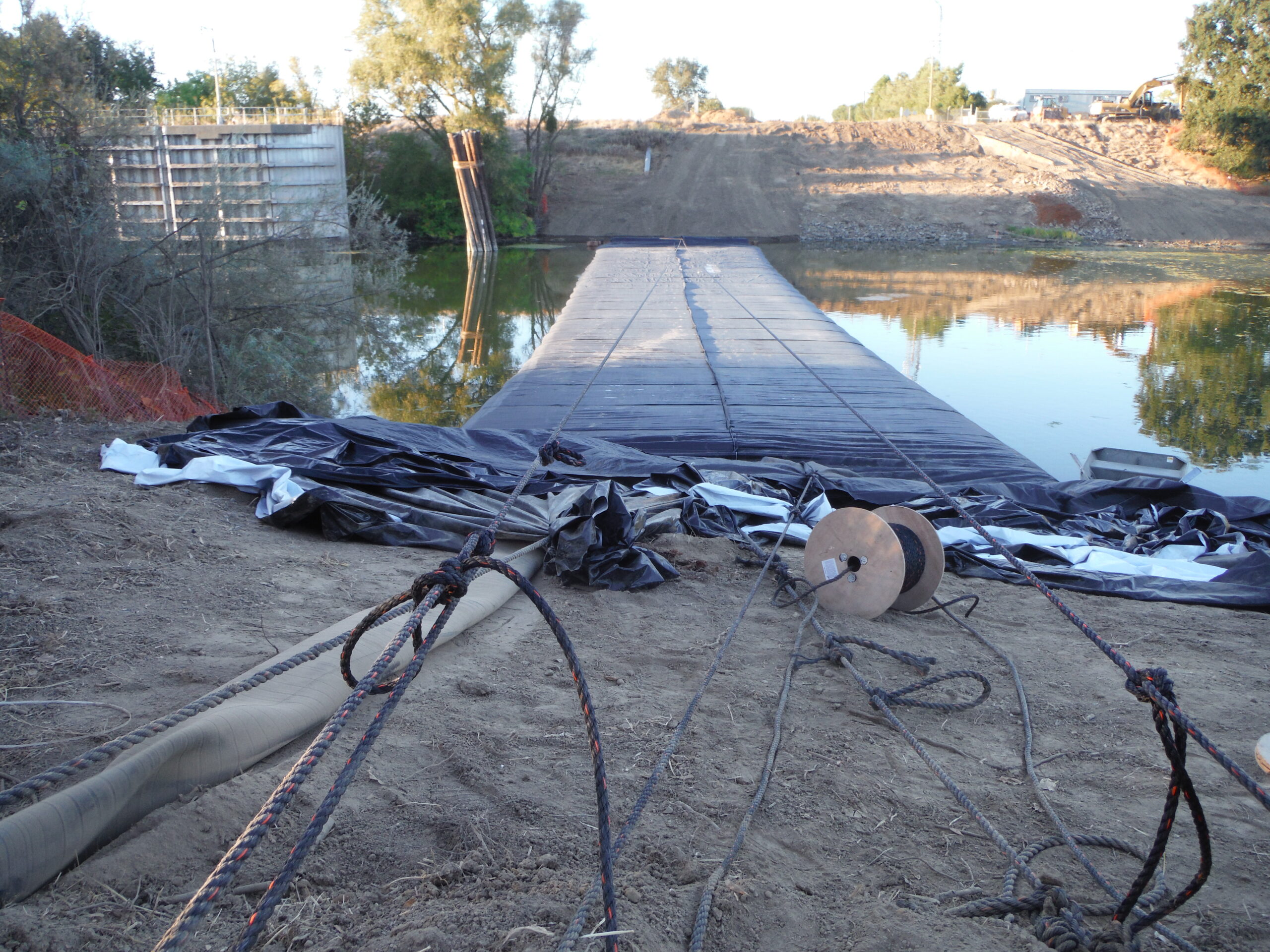
17.) The first 16ft tall SCE AquaDam continues to fill and has head above the surrounding water. Several feet of rope are typically used for the installation and removal of AquaDams.
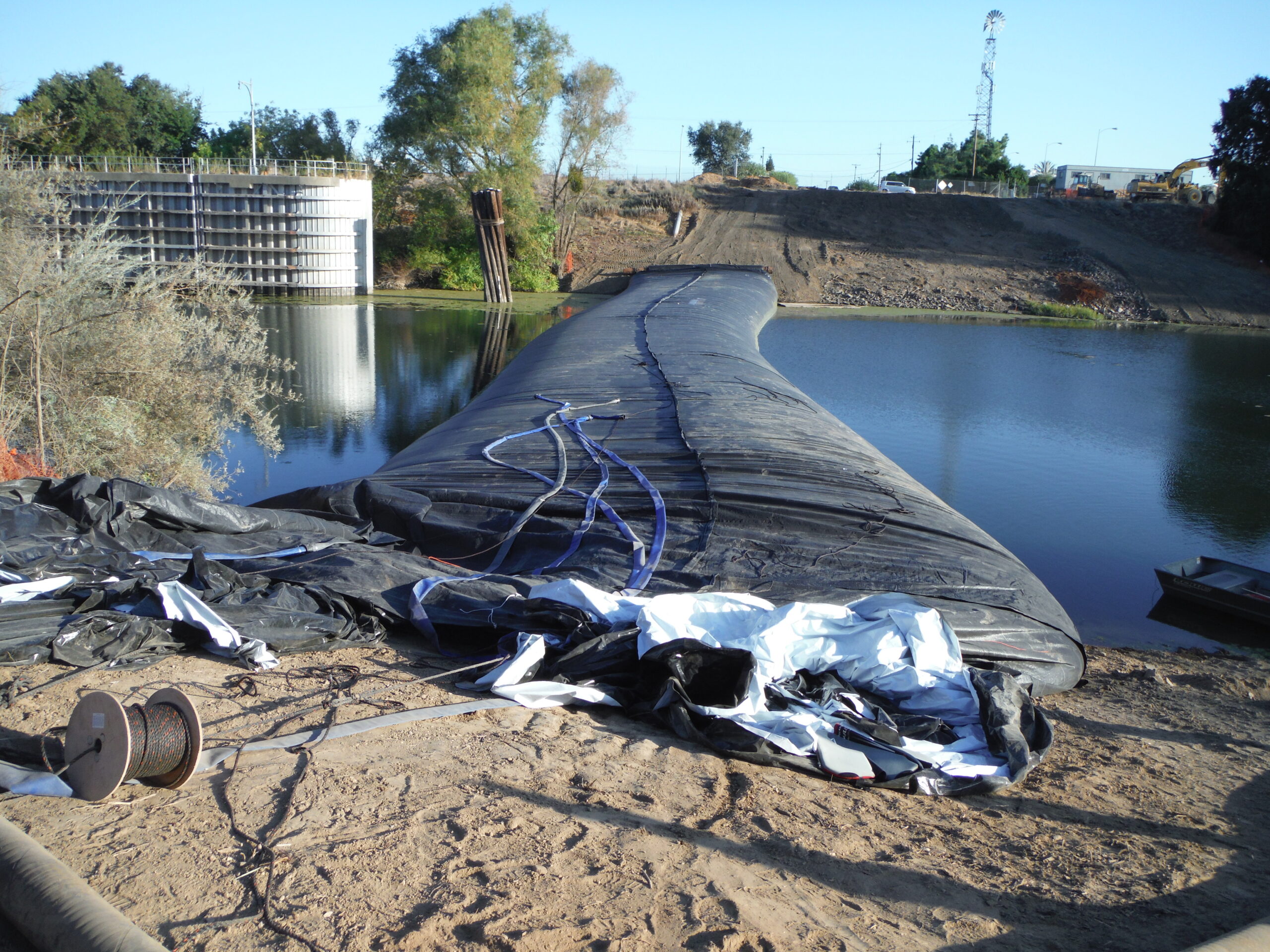
18.) High tide came, the ropes released the roll end, the AquaDam unrolled to its ending bank, and the first 16ft tall SCE AquaDam was filled. Workers removed the discharge hoses and tied up the fill-tubes.
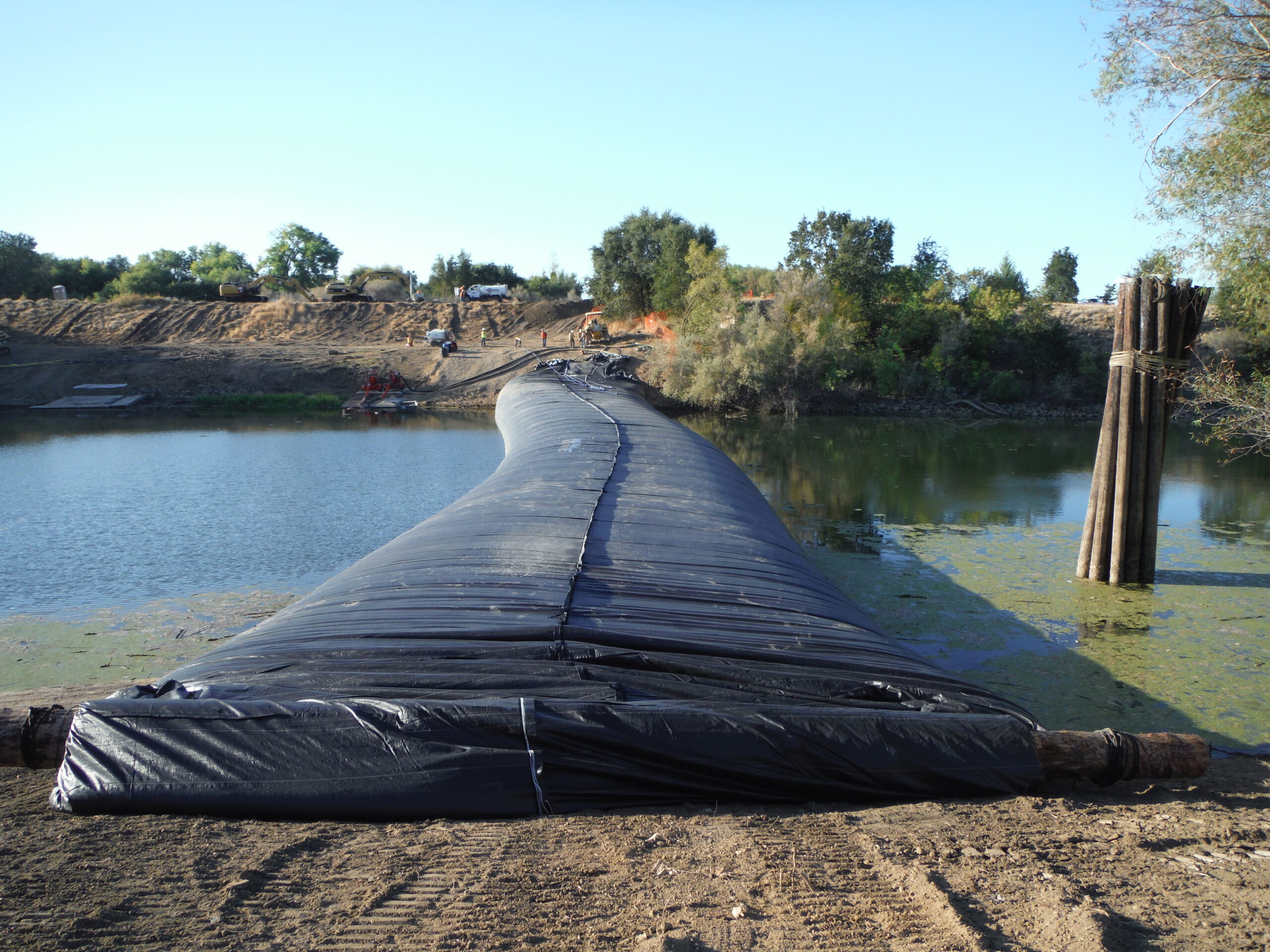
19.) A photo from the ending bank, looking at the first 16ft tall SCE AquaDam full.
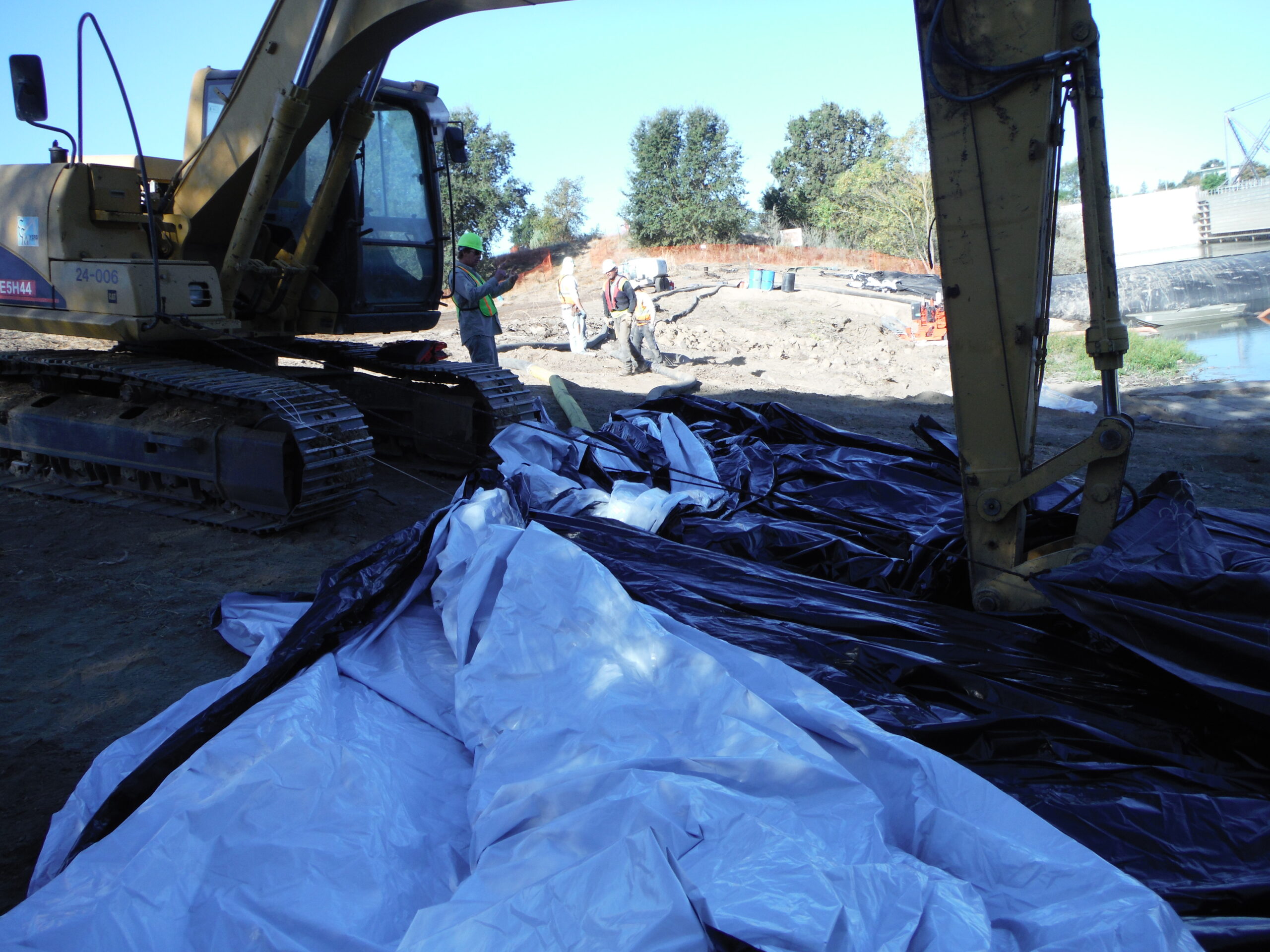
20.) The open end of the second 16ft tall SCE AquaDam have been tied back to keep the unit in place while it is filled with water.
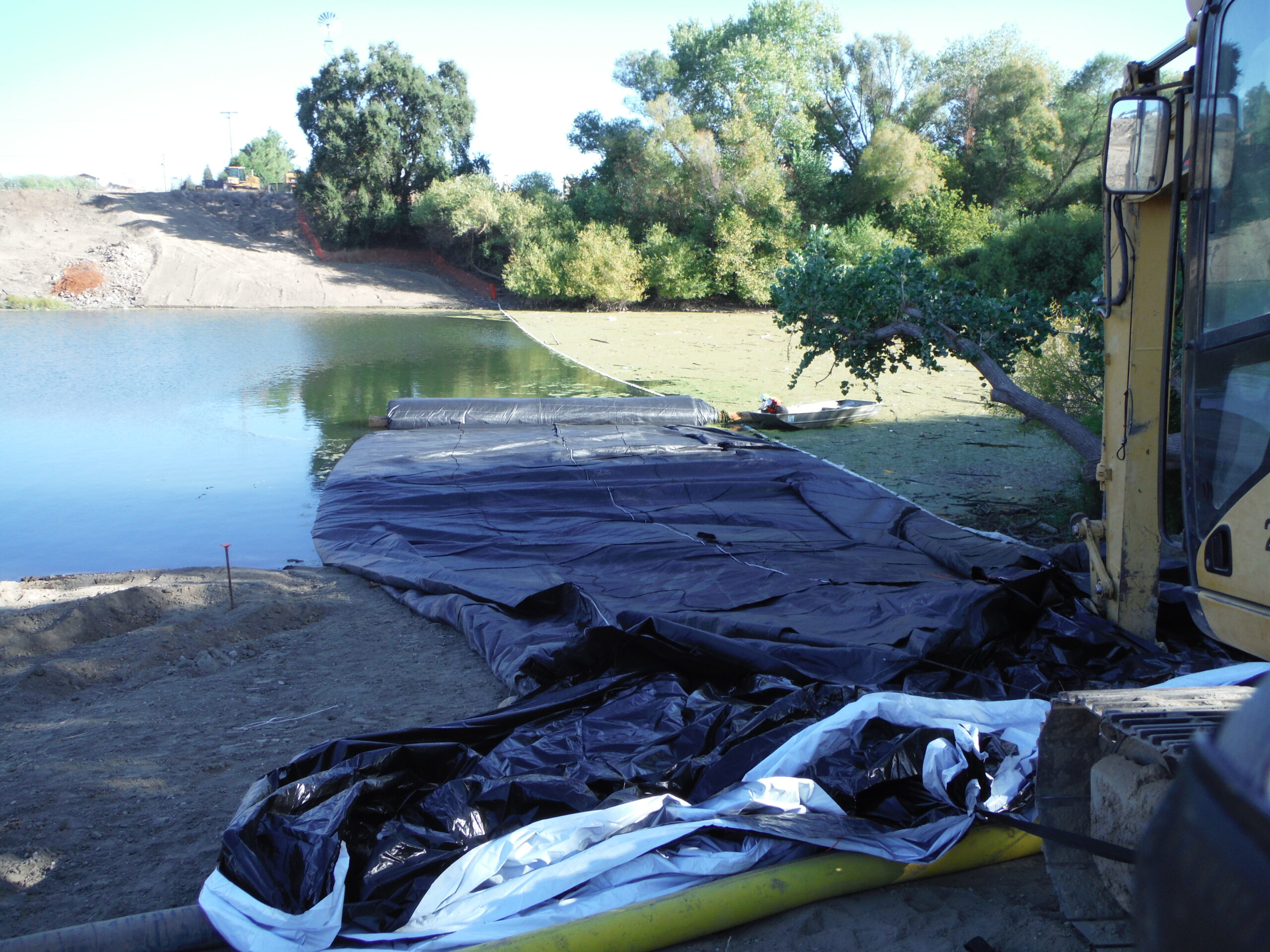
21.) The second 16ft tall SCE AquaDam is in the water and being filled.
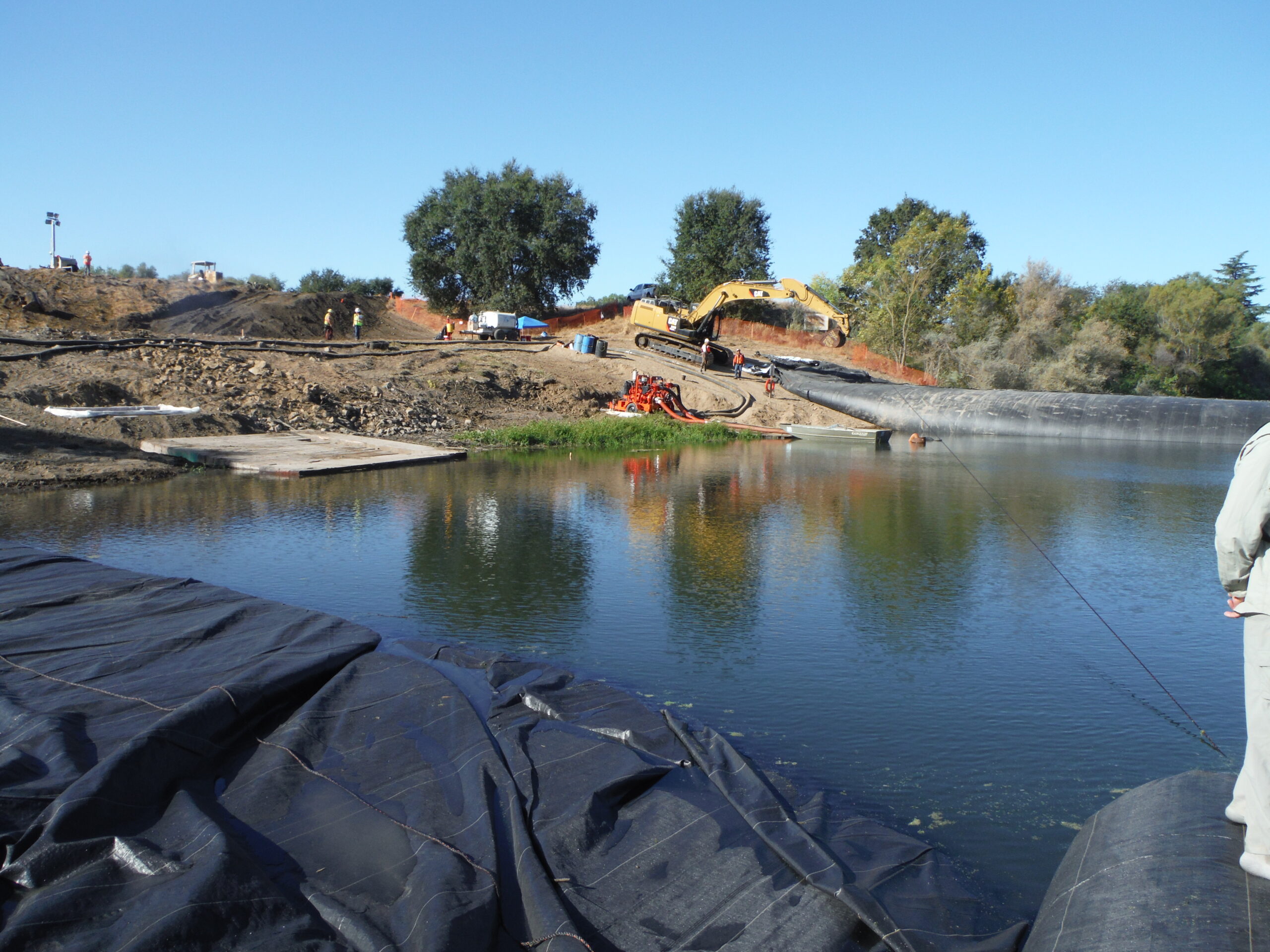
22.) A rope was tied to the extra material on the bottom seam and an excavator to pull the AquaDam as it is filled, into the desired angle to meet the ending bank.
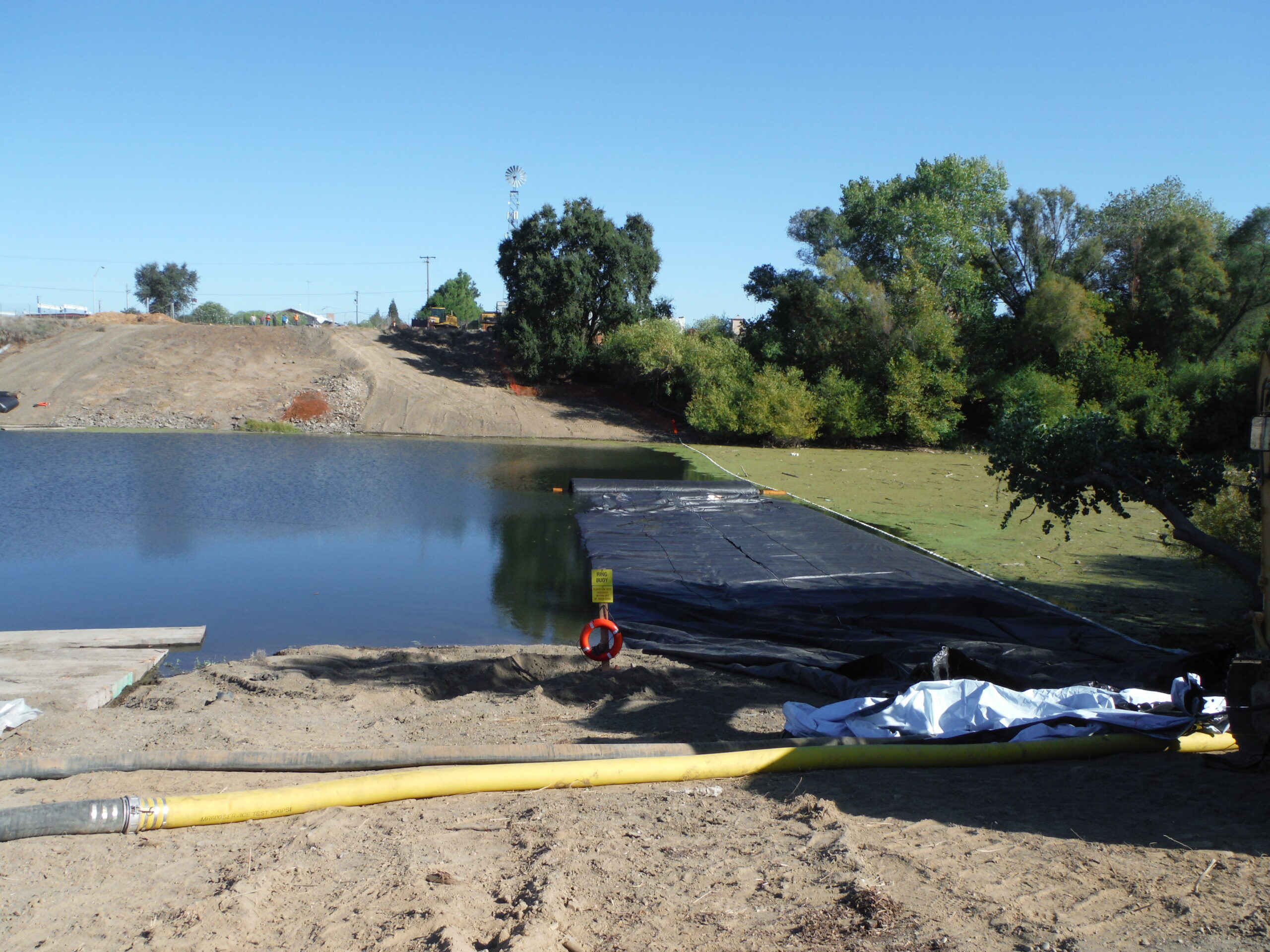
23.) The second 16ft tall SCE AquaDam continues to fill.
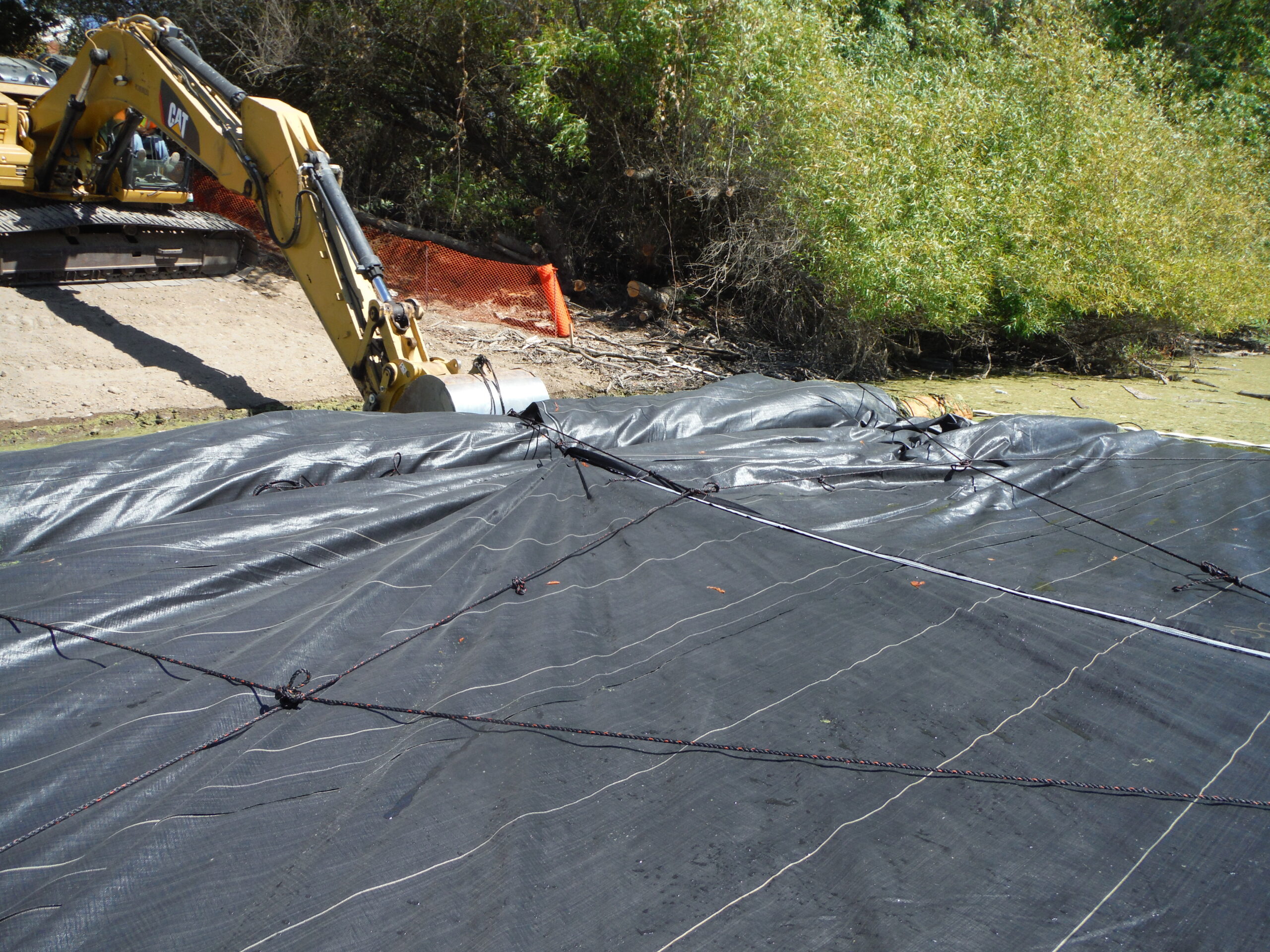
24.) As the second 16ft tall SCE AquaDam approached its ending bank, the angle of the roll needed to be adjusted. A series of ropes and an excavator were used to make those adjustments.
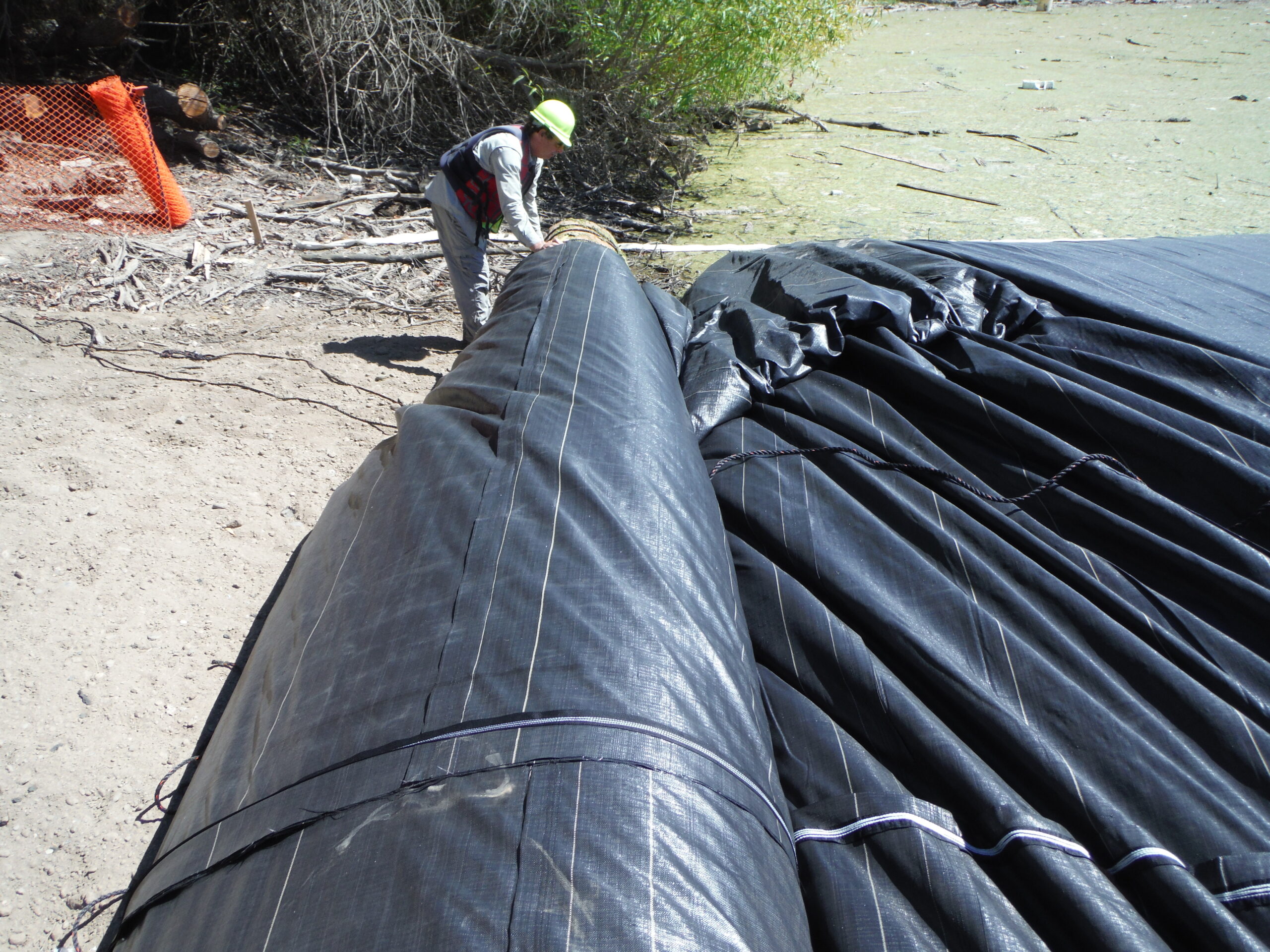
25.) The second 16ft tall AquaDam has unrolled to its ending bank and now the unit will need to finish filling.
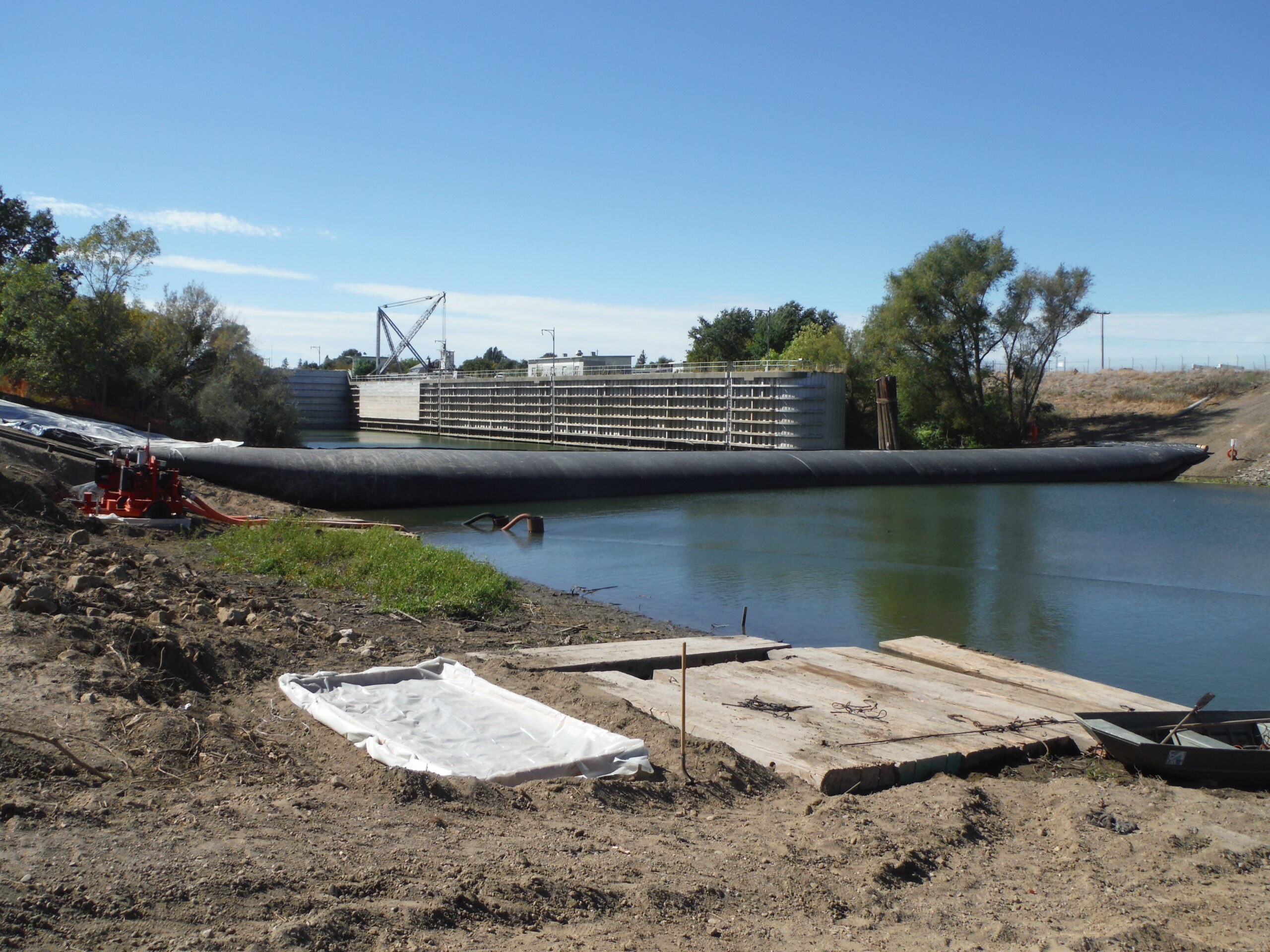
26.) Looking West towards the locks at the first 16ft tall AquaDam after it has been installed and in action.
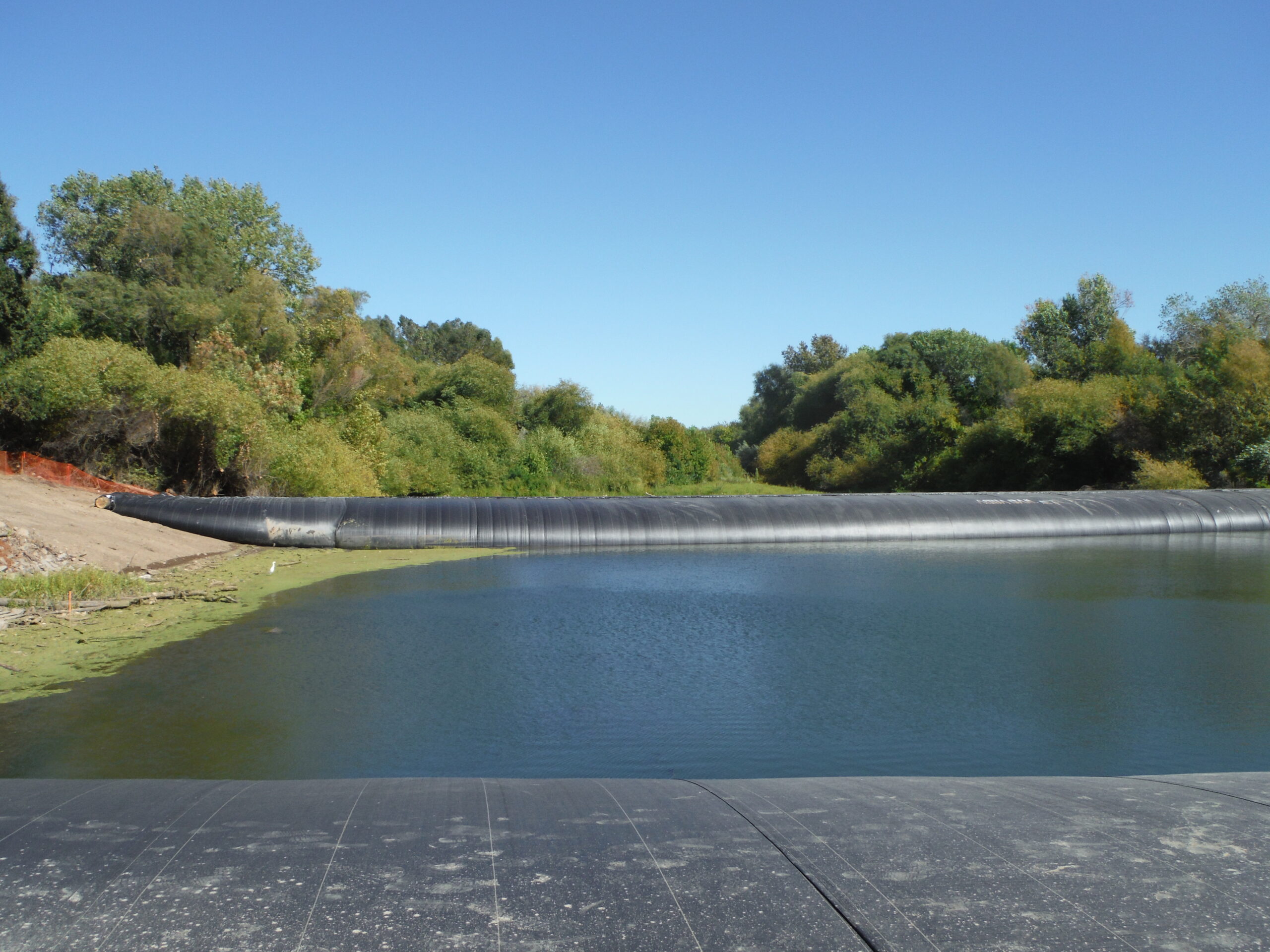
27.) Look East towards Sacramento River at the second 16ft tall AquaDam installed and in action.
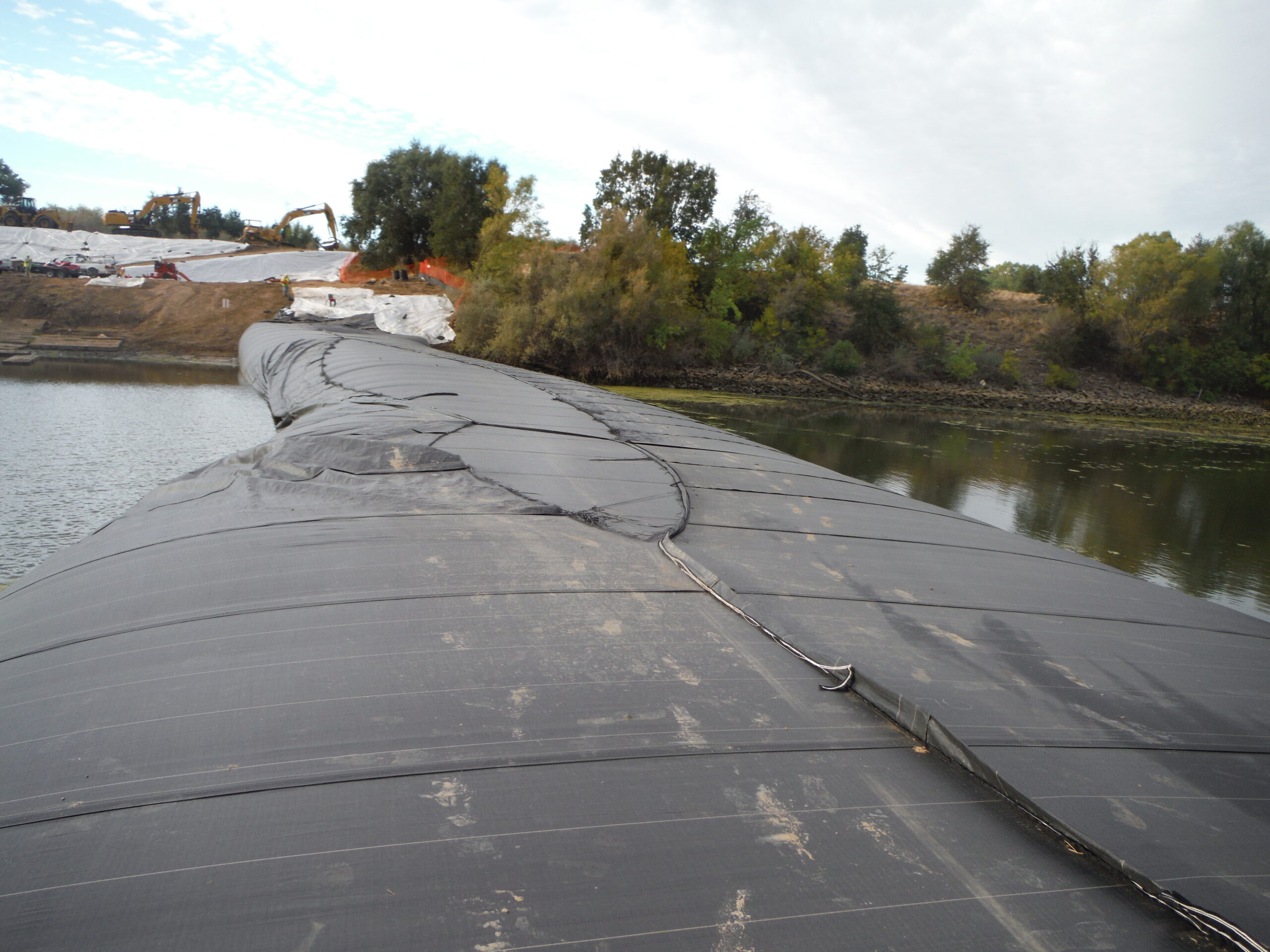
28.) A few days later, the first 16ft tall SCE AquaDam was vandalized and needed to be replaced.
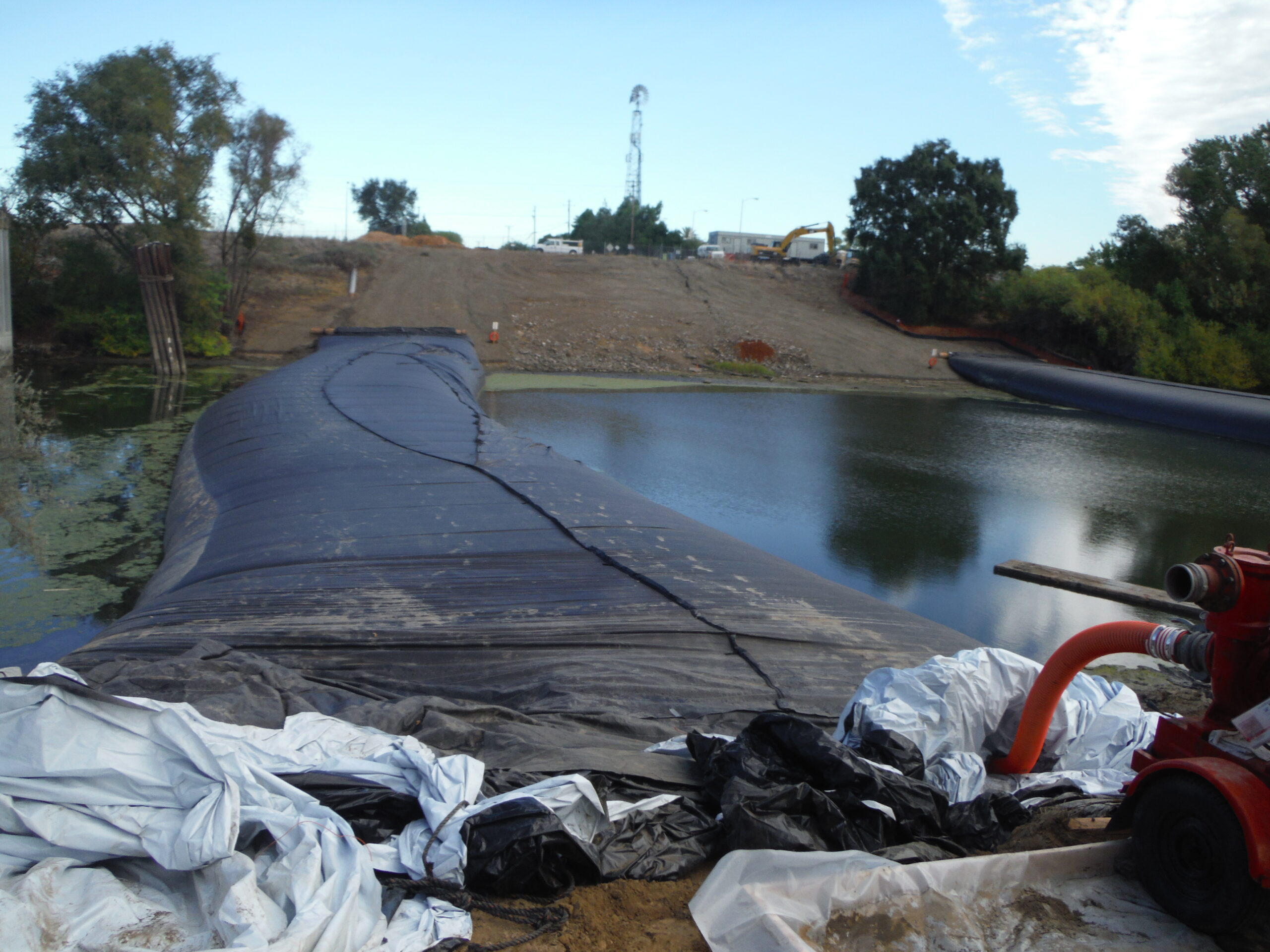
29.) Suction hose (without fittings or sharp edges) from a pump use inserted into the right fill-tube and the water inside of the AquaDam was pumped out. Can you see the watermark on the left side of the AquaDam? Re-watering the work area is important for removal.
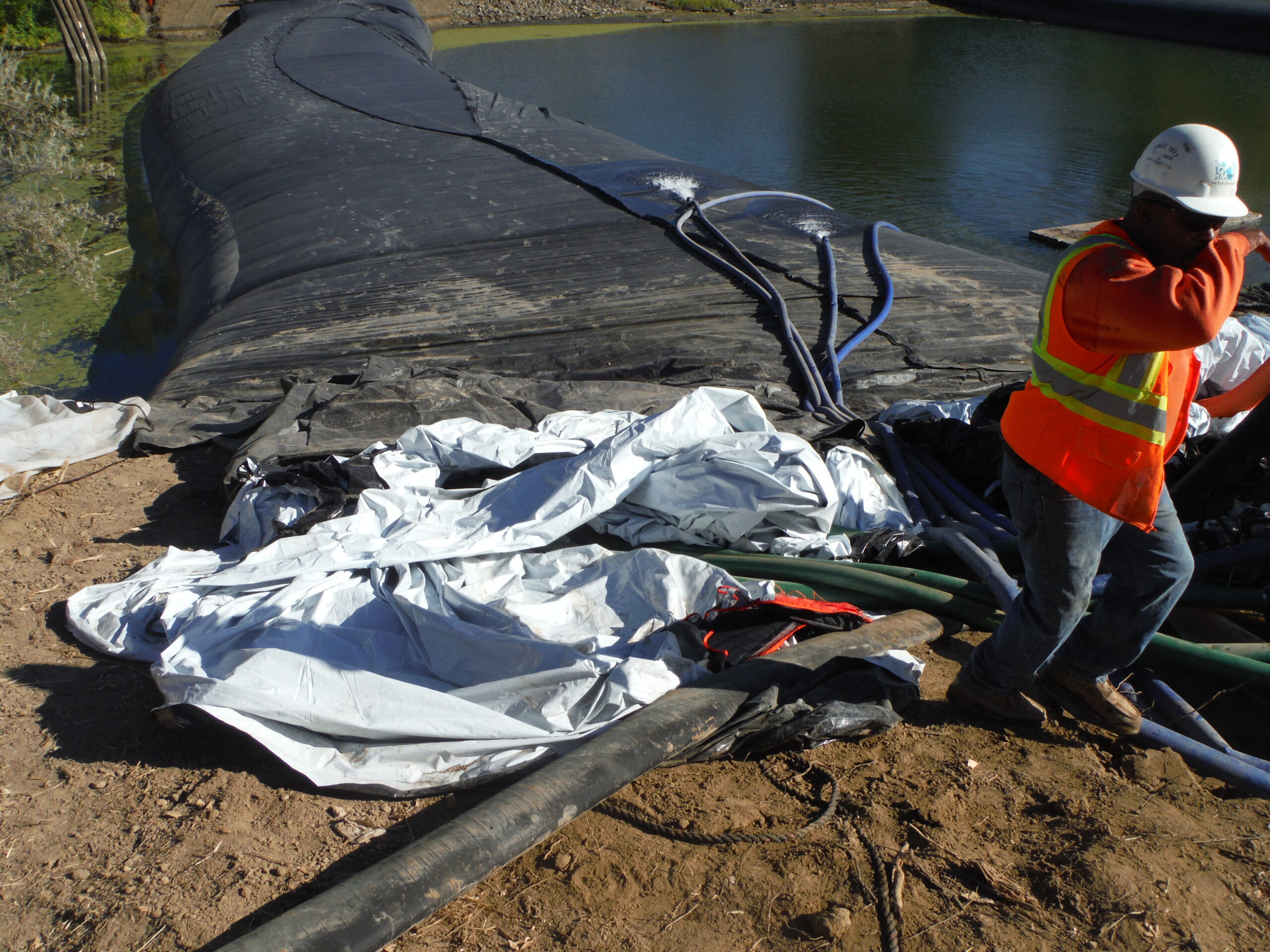
30.) Four smaller pumps were used on the left fill-tube to remove the water from inside of the 16ft tall AquaDam.
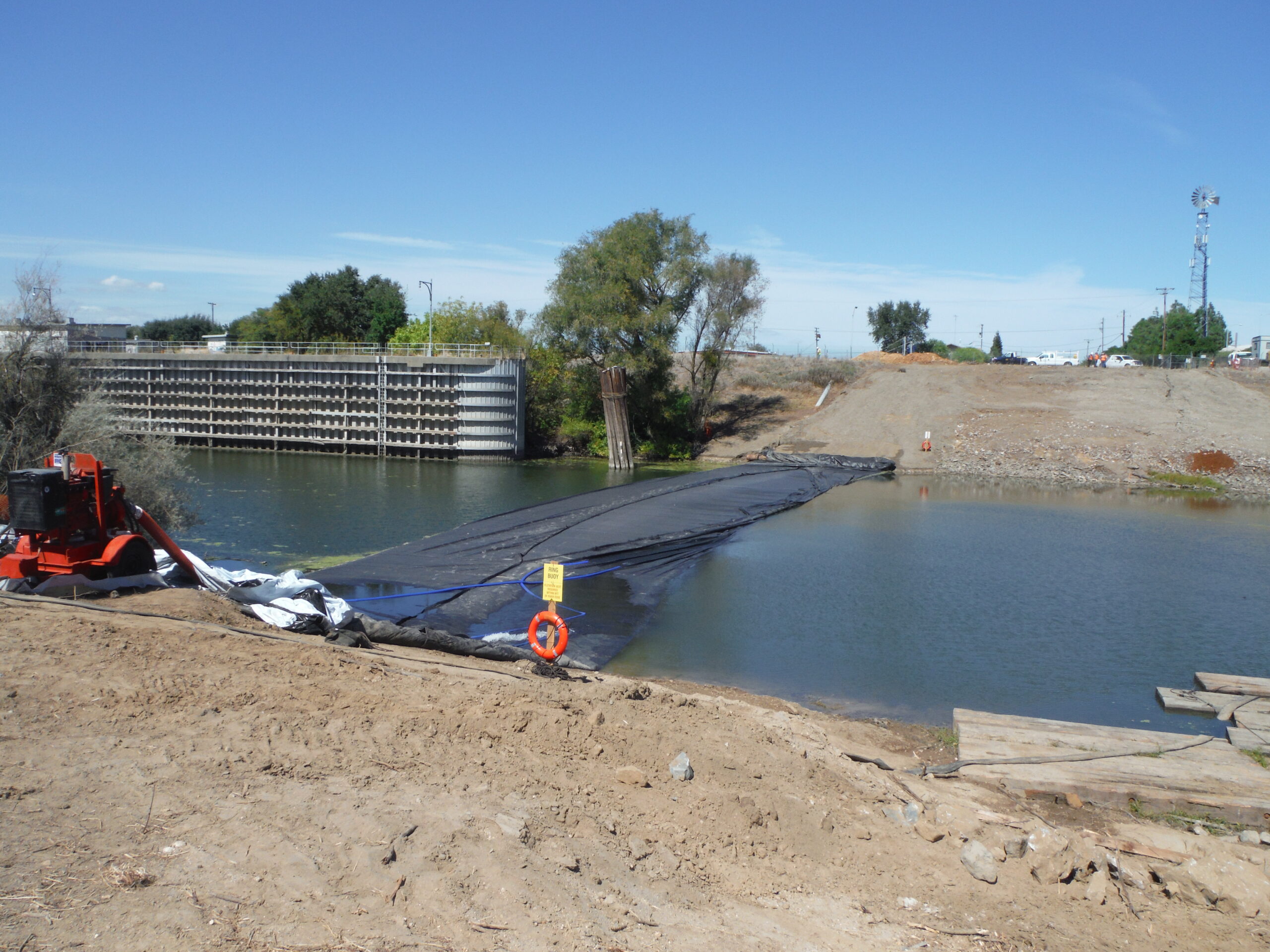
31.) Enough water needed to be removed from inside the AquaDam so that the unit would be level with the surrounding water.
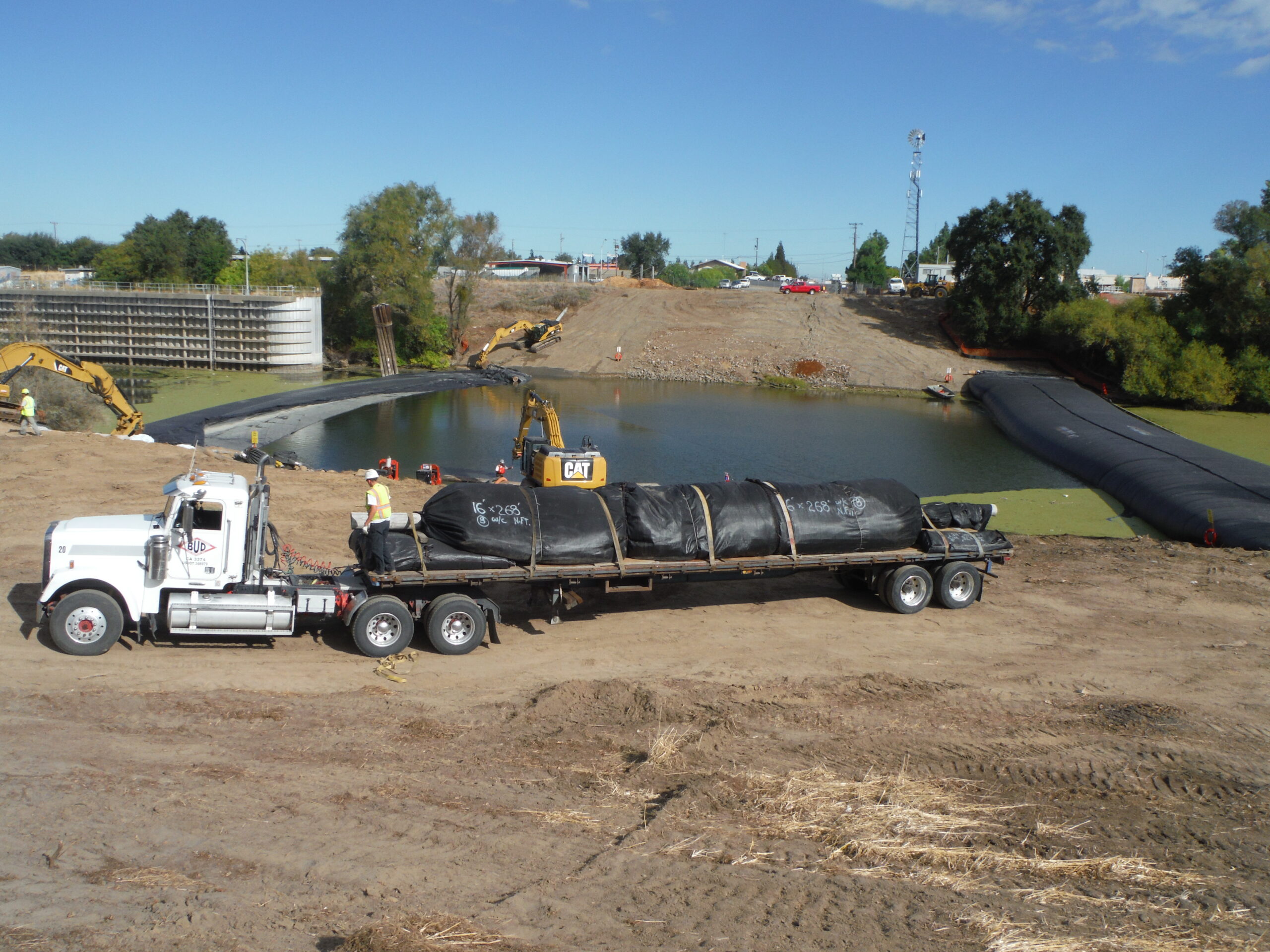
32.) The third 16ft tall SCE AquaDam has arrived on site.
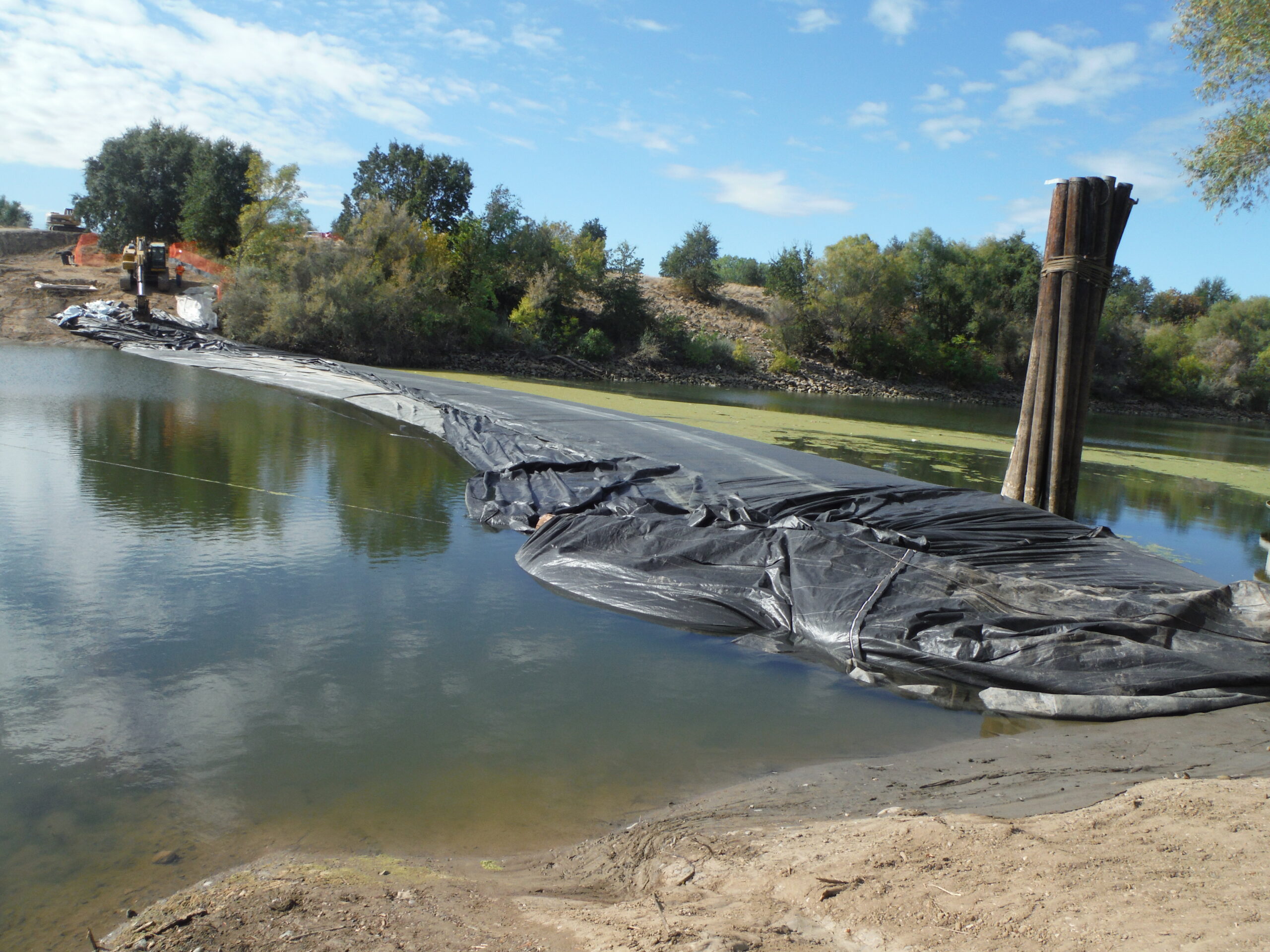
33.) Once the first 16ft tall AquaDam had enough water removed, the rolled end was pulled and pushed off its ending bank. The open end and fill-tubes were also pushed into the water. The workers wanted the AquaDam in the water and floating.
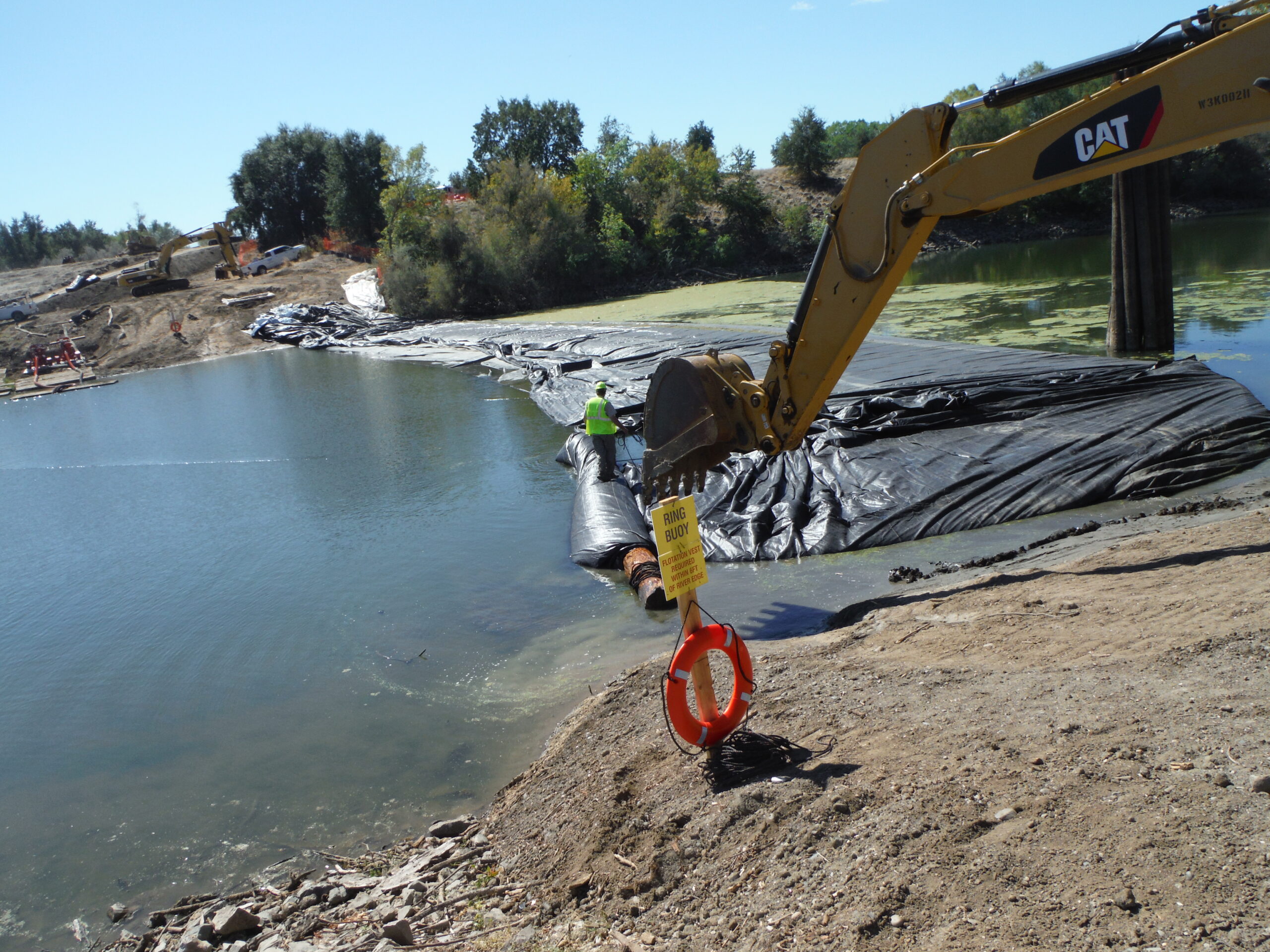
34.) Workers maneuver the roll end into the water and towards the bank where the unit was launched from, South side. This is because the equipment needed to remove the AquaDam was at that bank.
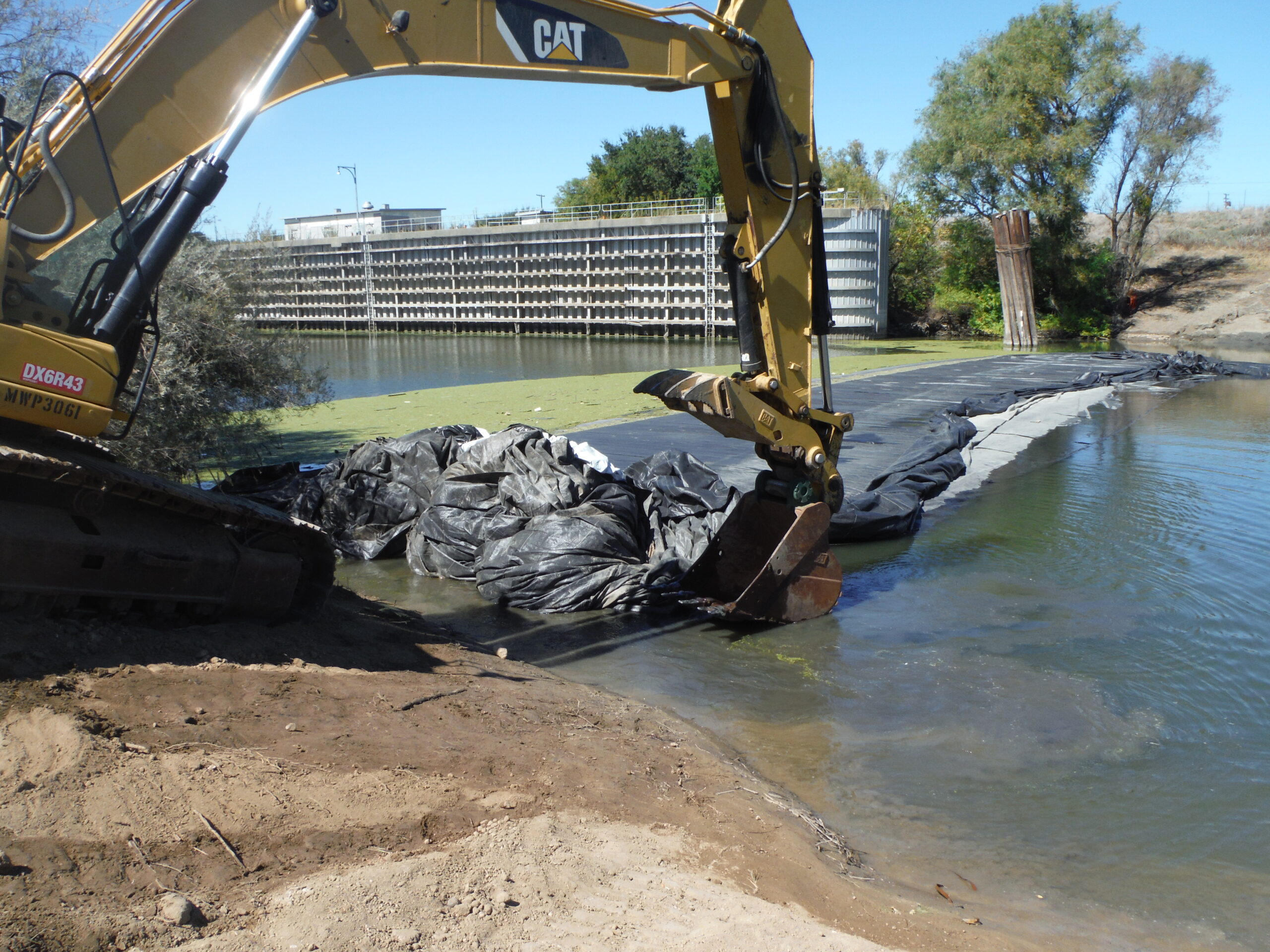
35.) The fill-tubes needed to be opened and in the body of water, so that the water inside could exit.
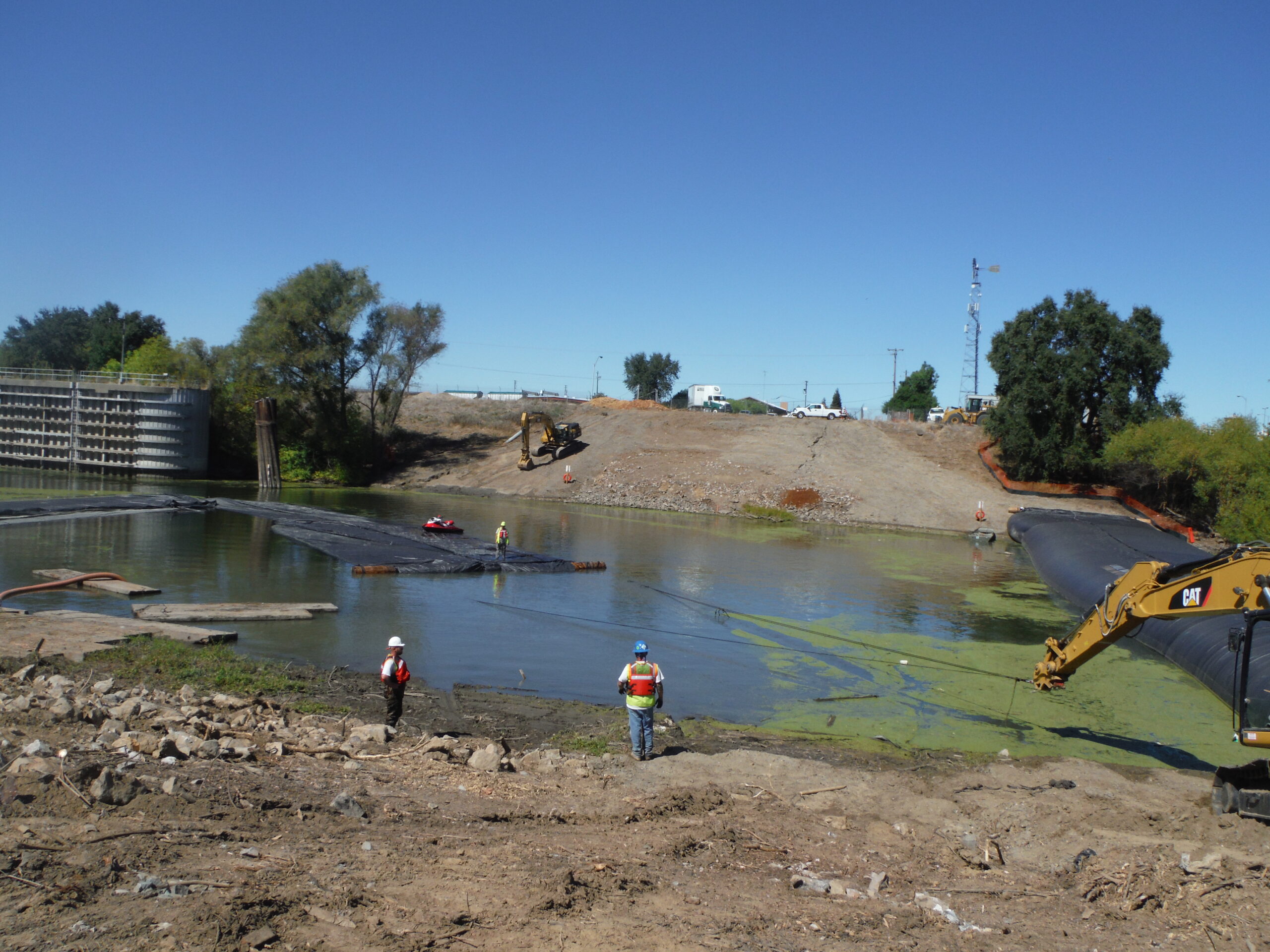
36.) Workers use CAT equipment to pull the SCE AquaDam across the water towards the bank to remove it.
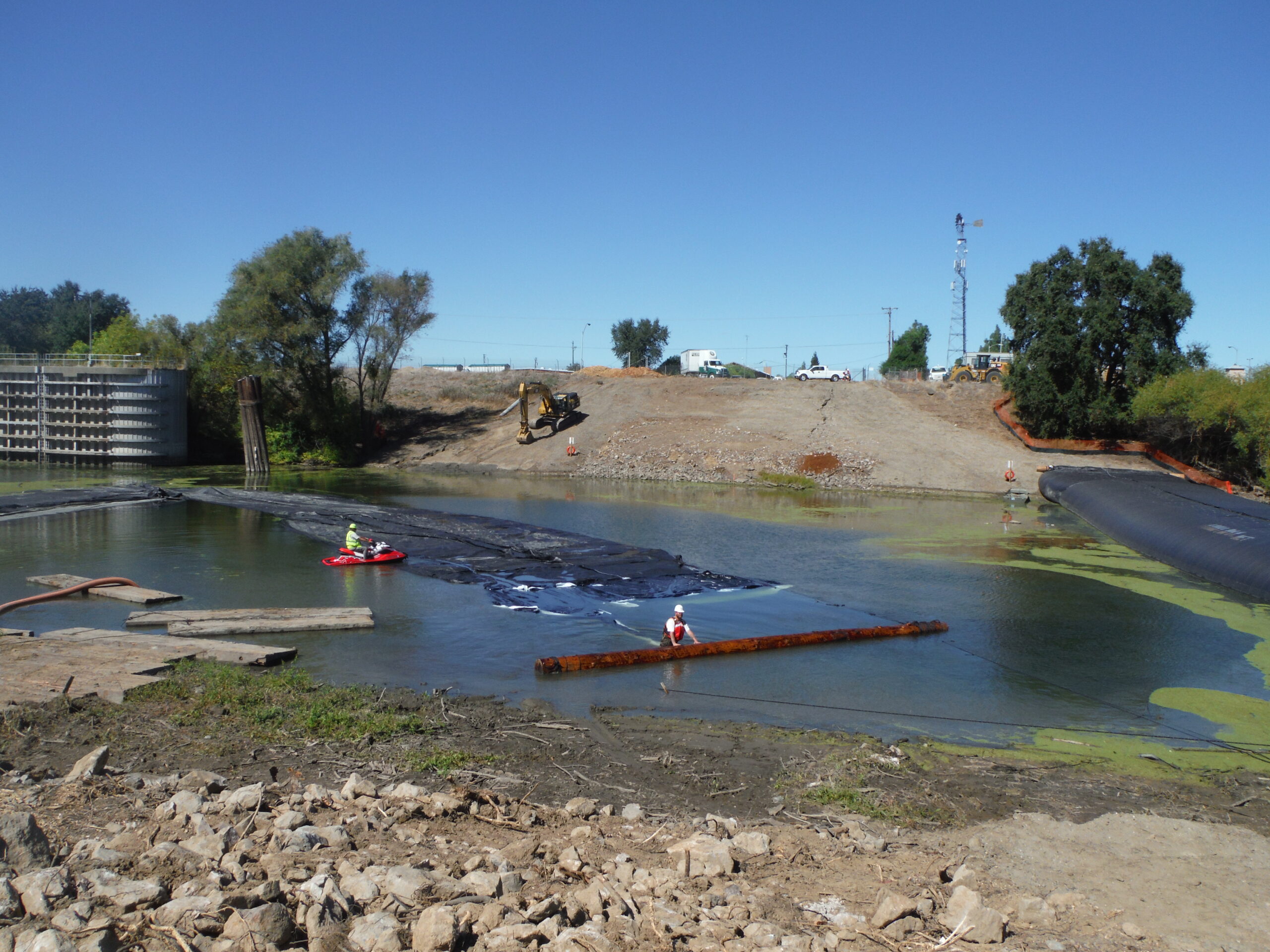
37.) Workers remove the log to reduce drag and weight.
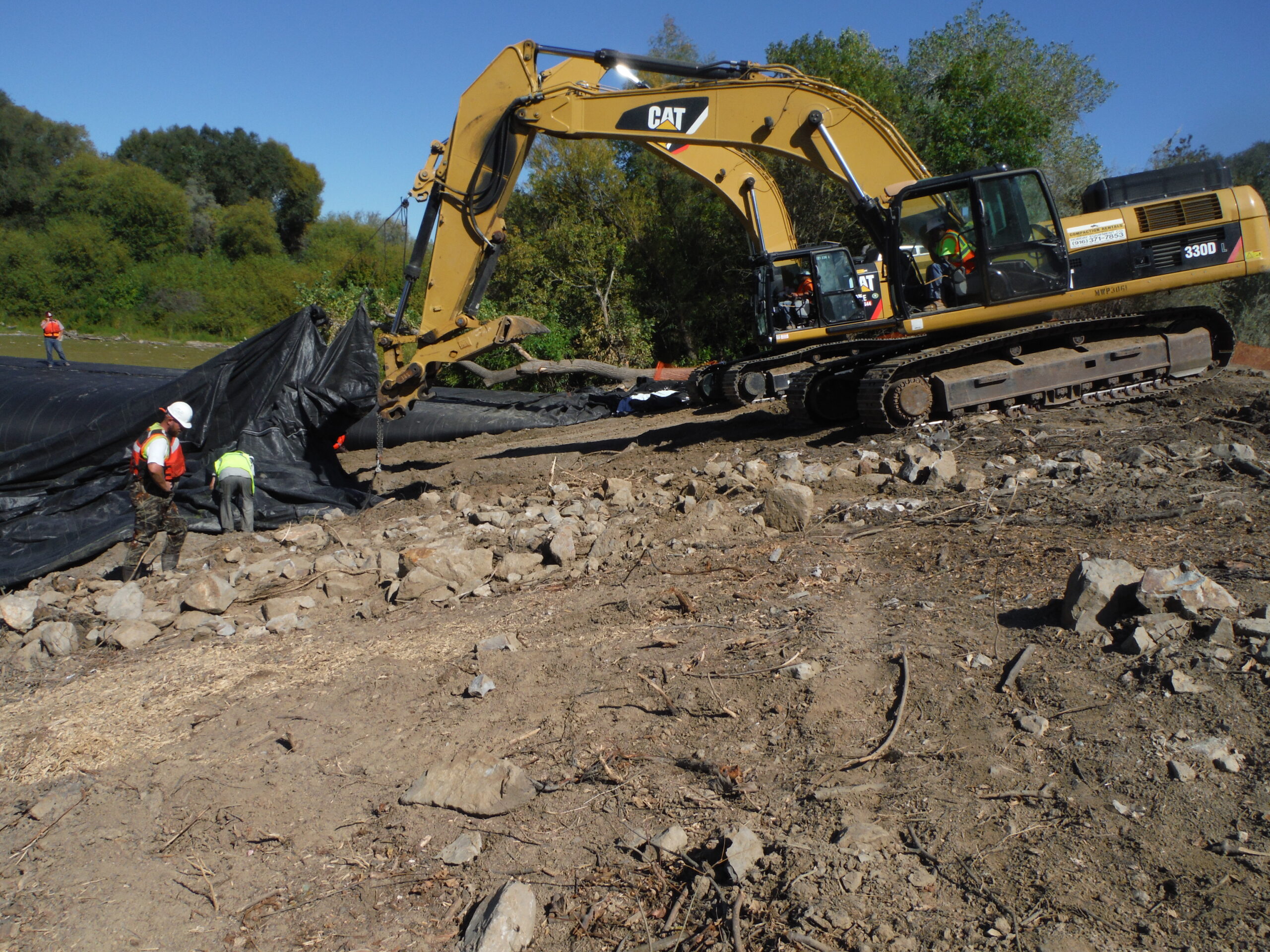
38.) Workers tie ropes from their equipment to the closed end of the SCE AquaDam to pull it back and up the bank, allowing water to slowly drain back into the body of water.
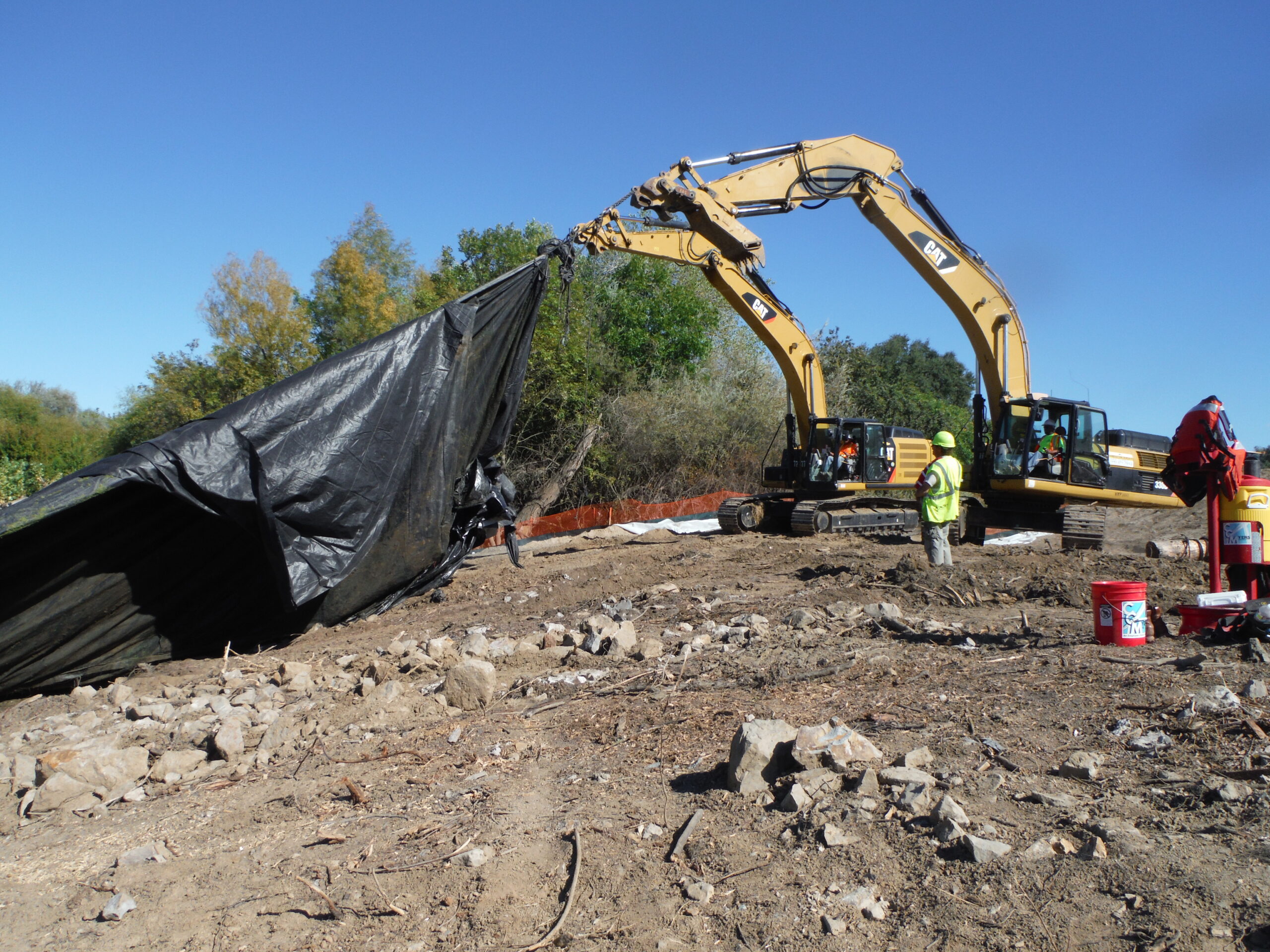
39.) The two excavators must work together to pull back and up all the way up the bank.
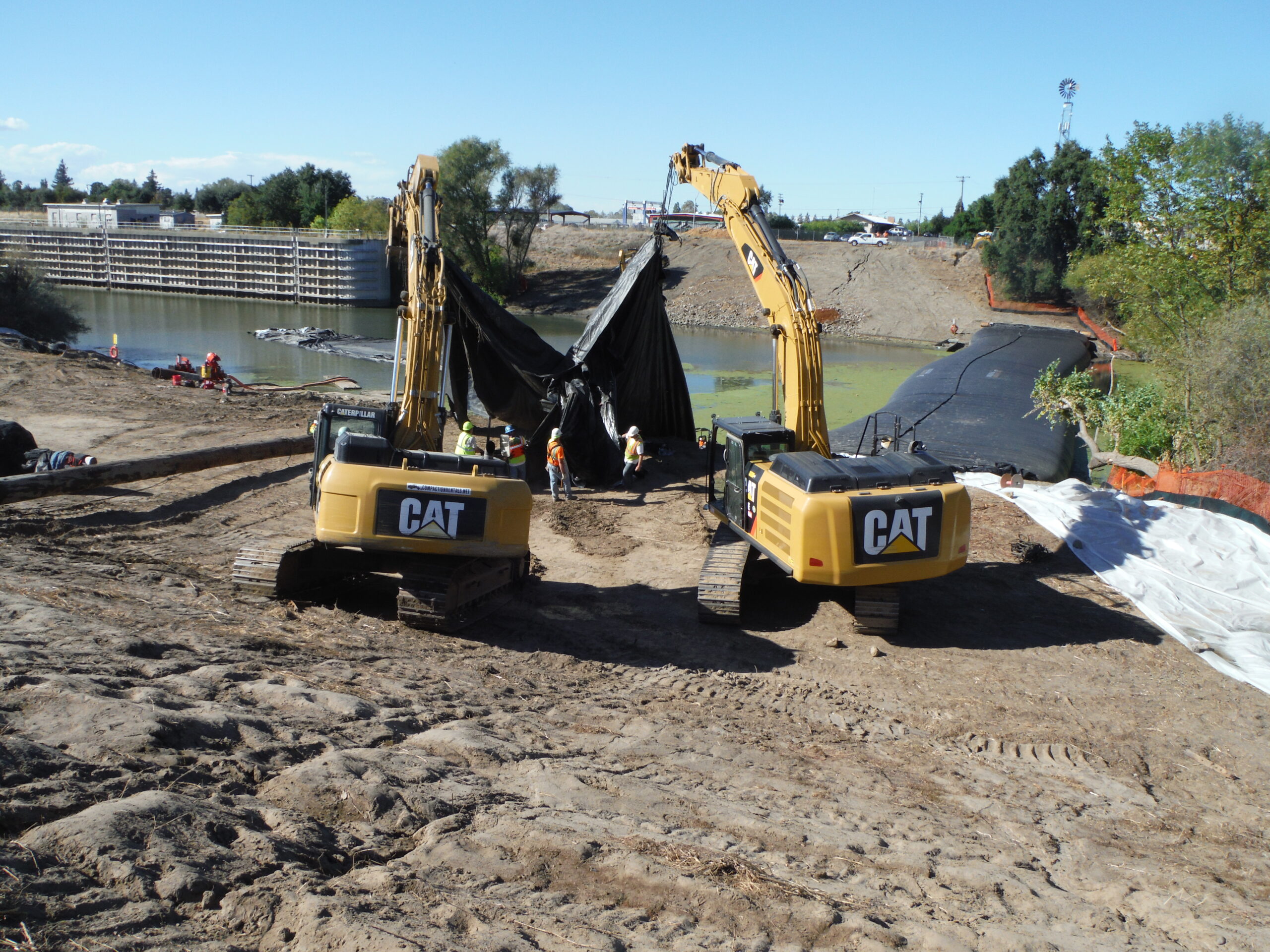
40.) Workers pulled the closed end of the first 16ft tall SCE AquaDam up the bank to a flat landing and lifted to help drain water.
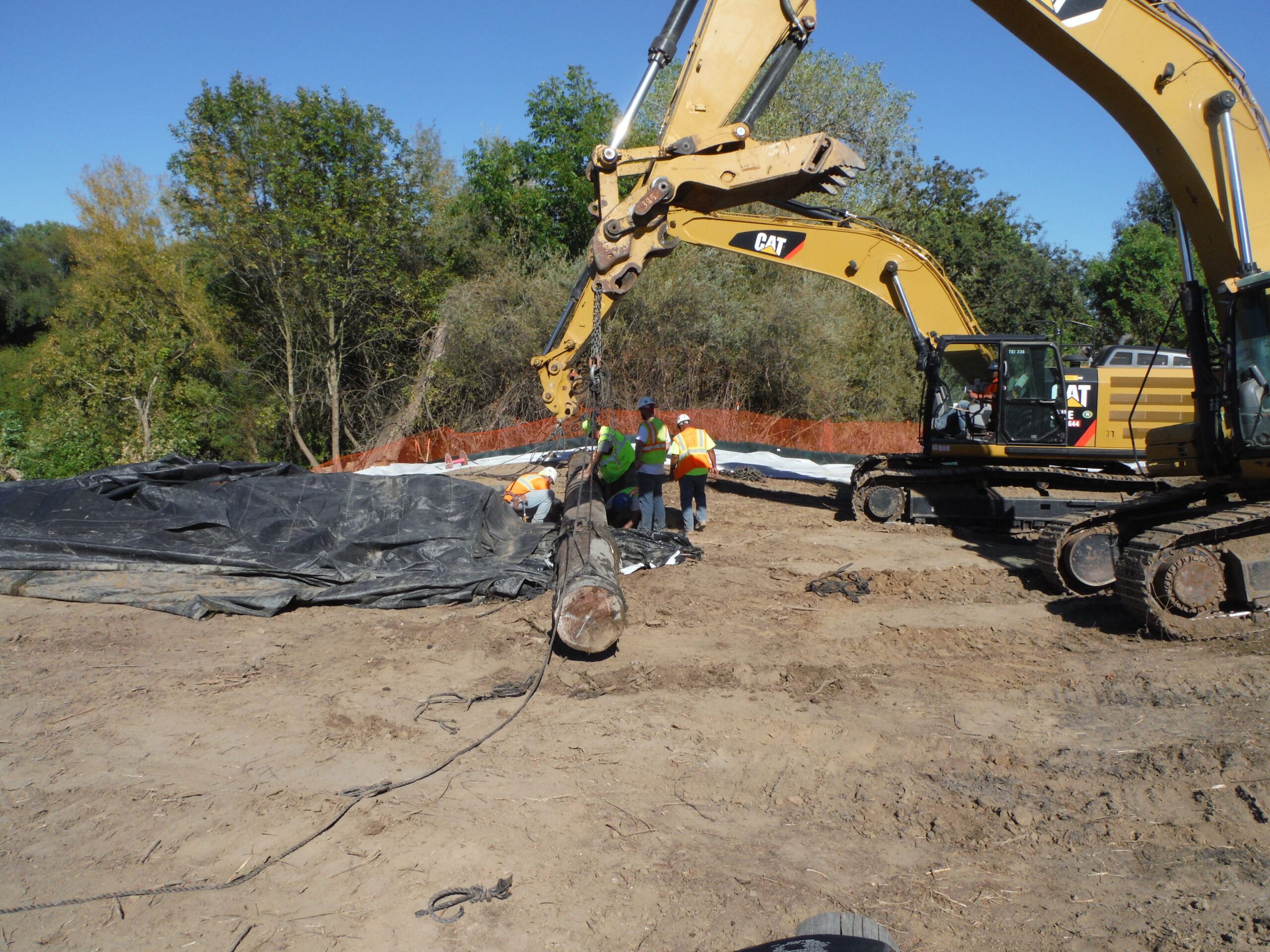
41.) After most of the water had drained the closed end was lowered and the log was re-attached to the closed end of the first 16ft tall SCE AquaDam.
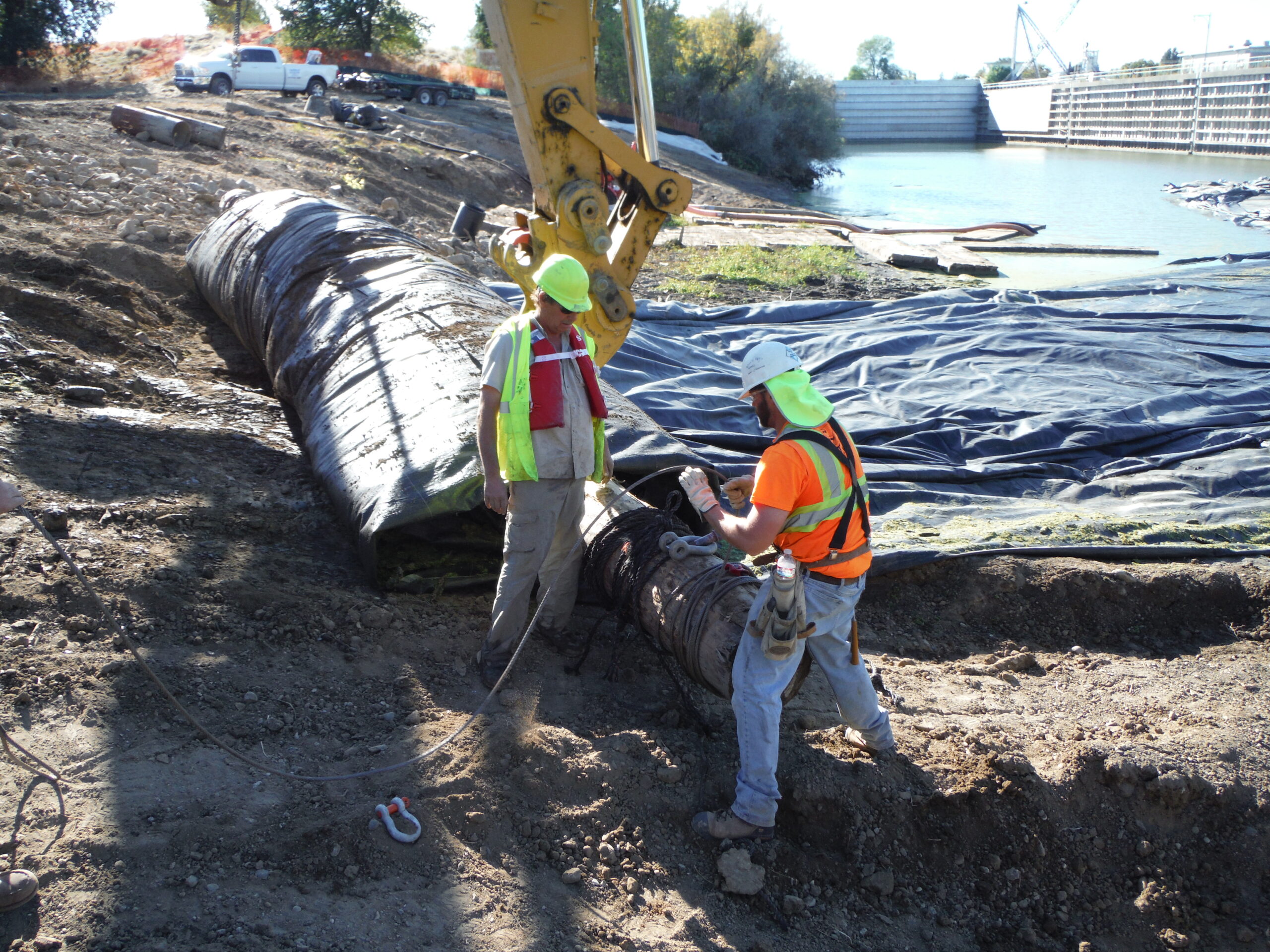
42.) Workers wound a cable around each end of the log so that when the cable was lifted the log would roll and AquaDam re-roll.
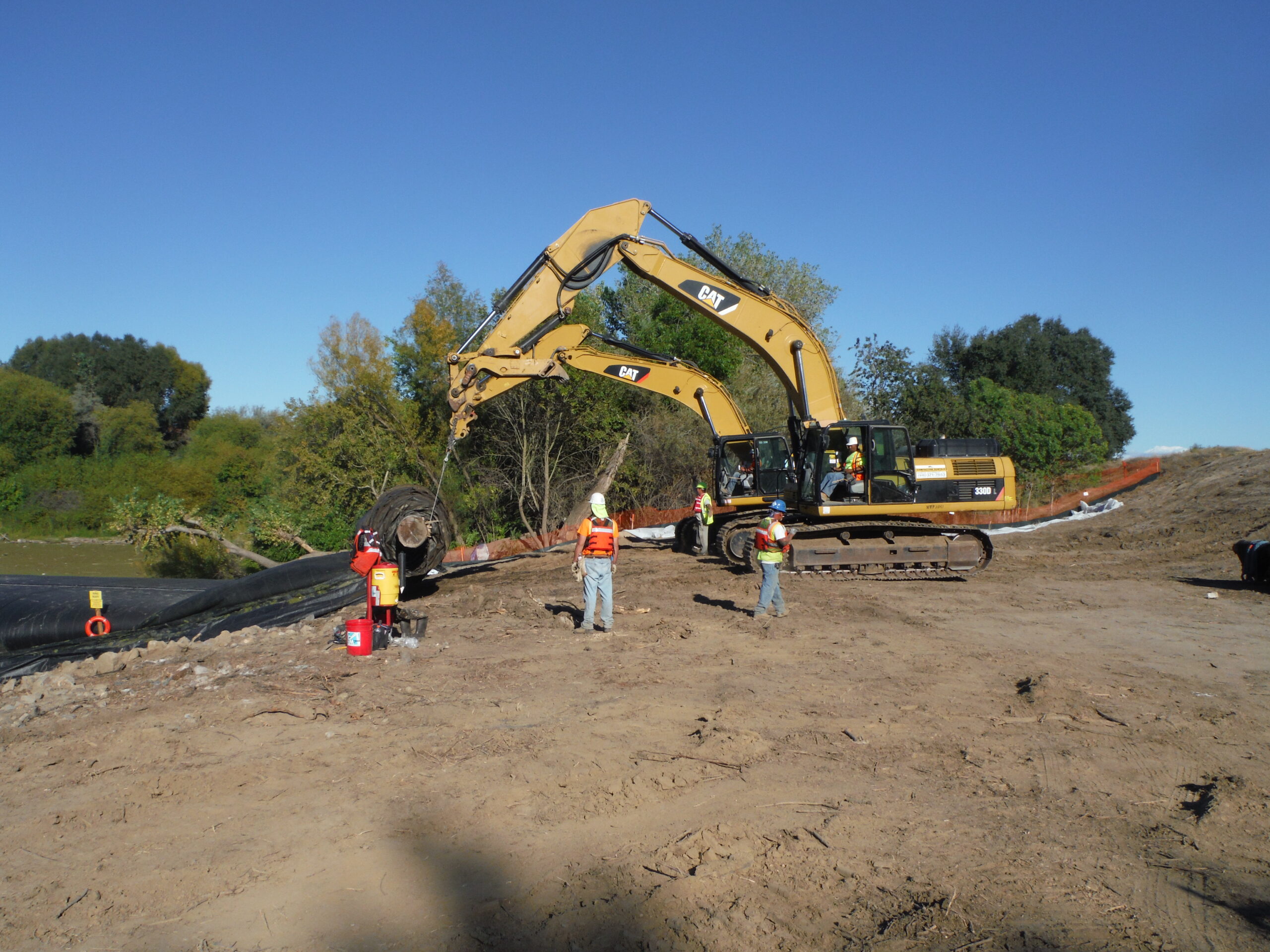
43.) An excavator on each side pulls the roll up the bank and then lift. While pulling the fill-tubes release the water inside to the surrounding body and unrolled length gets pulled up the bank. While lifting the AquaDam re-rolls and water drains. After the cables unrolled their length, workers re-wrapped them, and the re-rolling process is repeated.
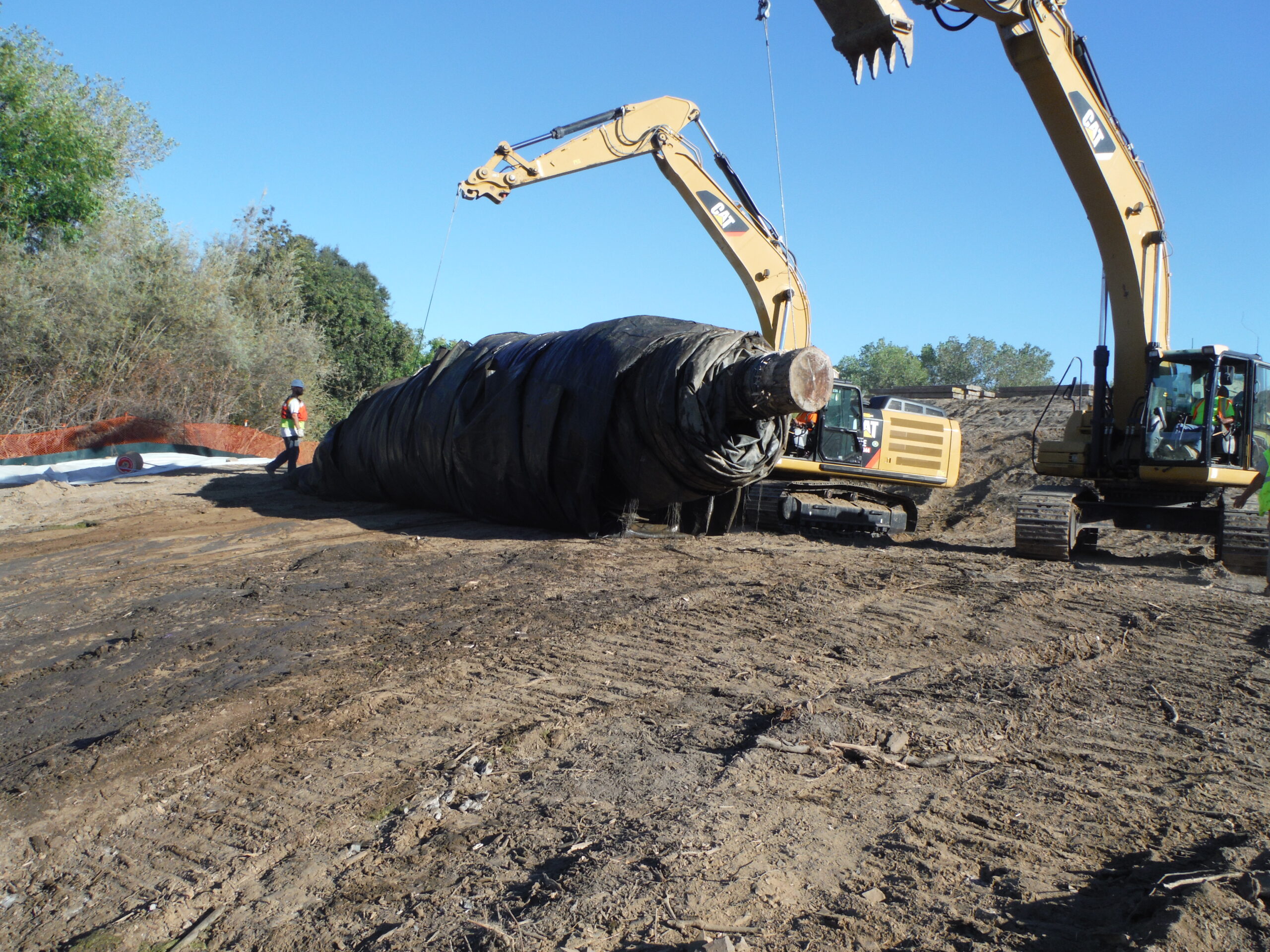
44.) The first 16ft tall SCE AquaDam has been drained and re-rolled to be shipped off site.
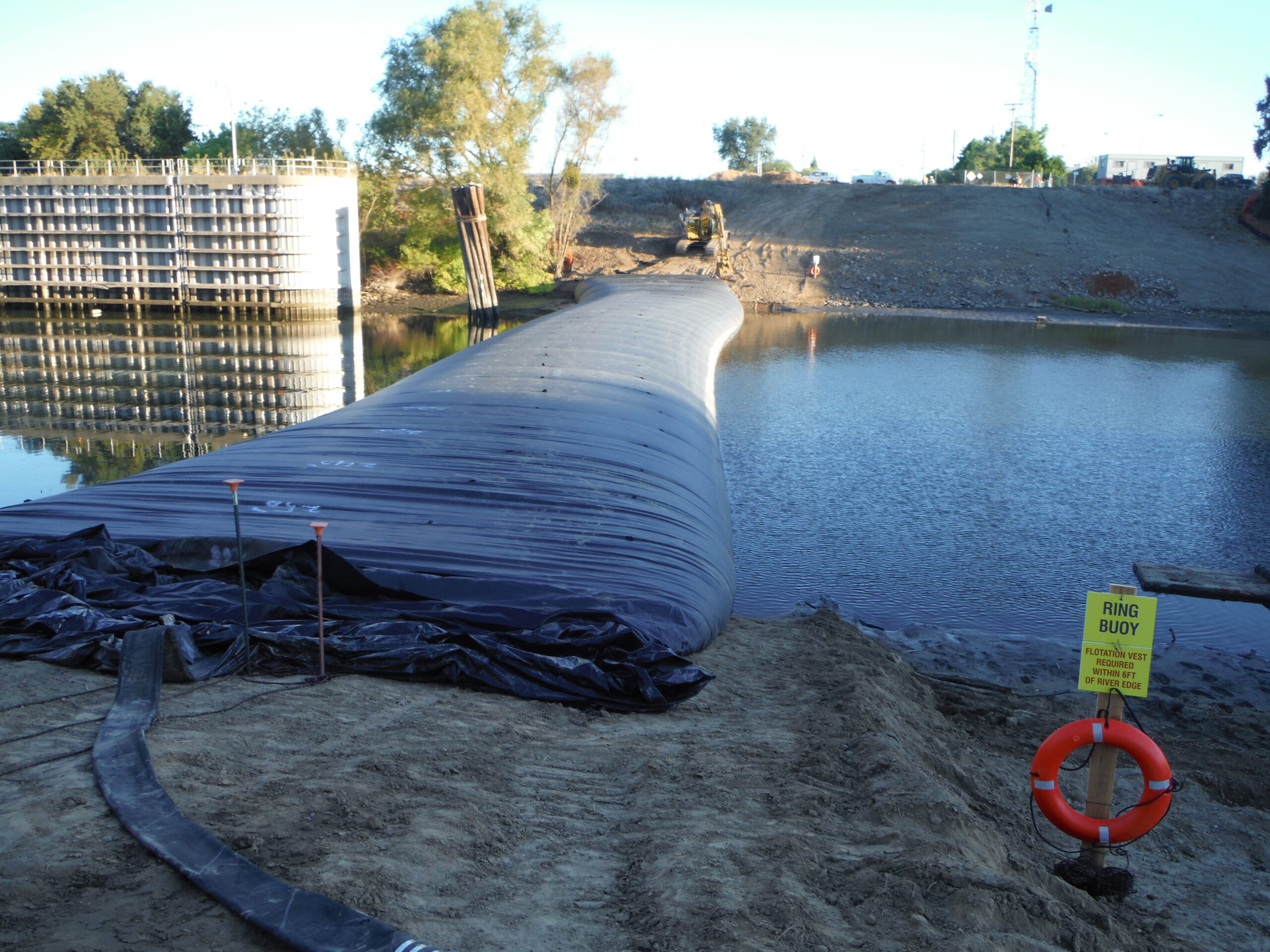
45.) The third 16ft tall SCE AquaDam fully installed a few days later.
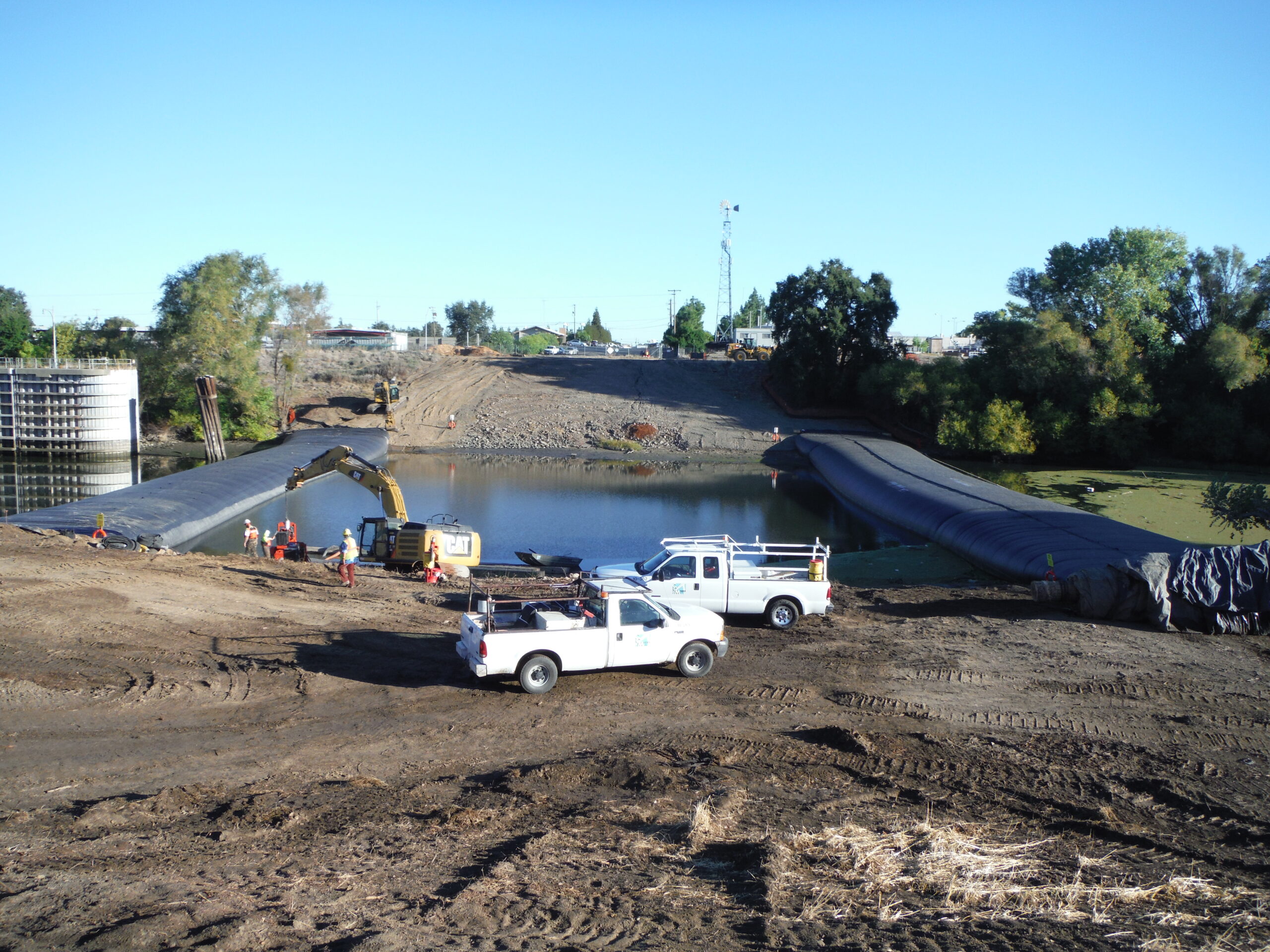
46.) Both 16ft tall SCE AquaDams installed and working. Great job AquaDam!

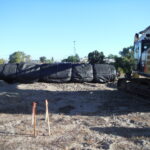

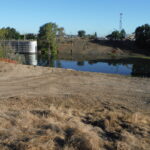
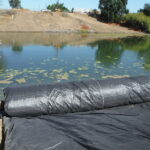
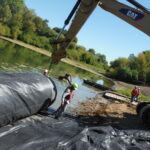
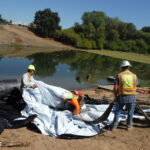
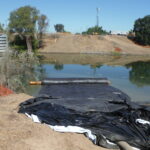
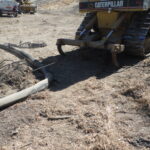
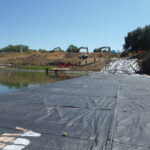
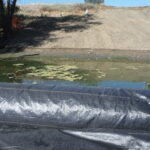
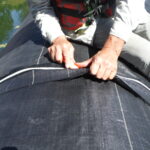
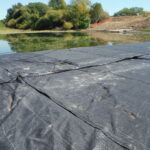
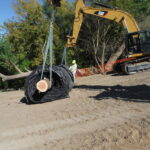
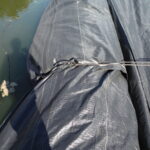
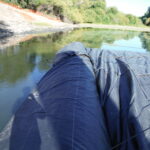
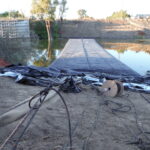
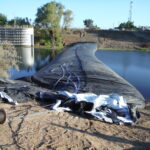
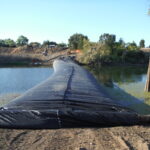
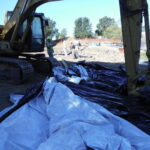
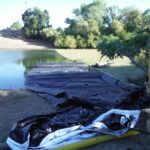
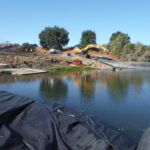
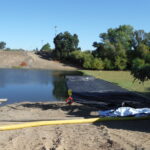
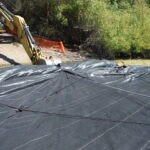
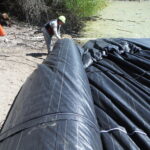
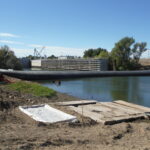
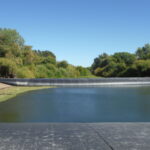
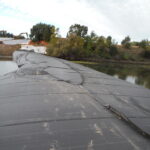
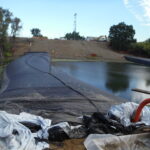
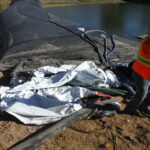

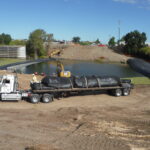
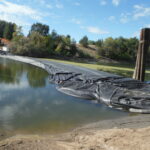
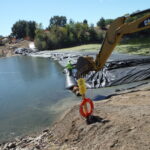
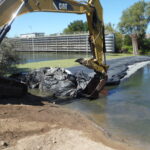
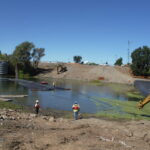
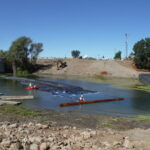


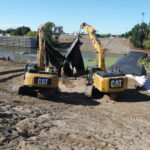
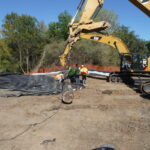
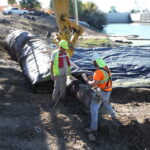
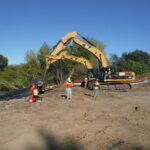
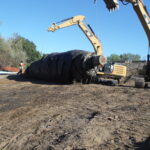
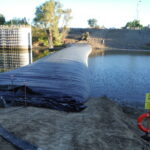
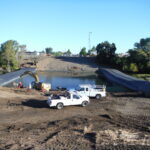
Three 16ft Tall 33ft Wide (full) 300ft Long Single Closed End (SCE) AquaDams, Barge Canal, McGowan Memorial Bridge Construction, Staggered Configuration, Replacement AquaDam, Tidal Influenced Water
